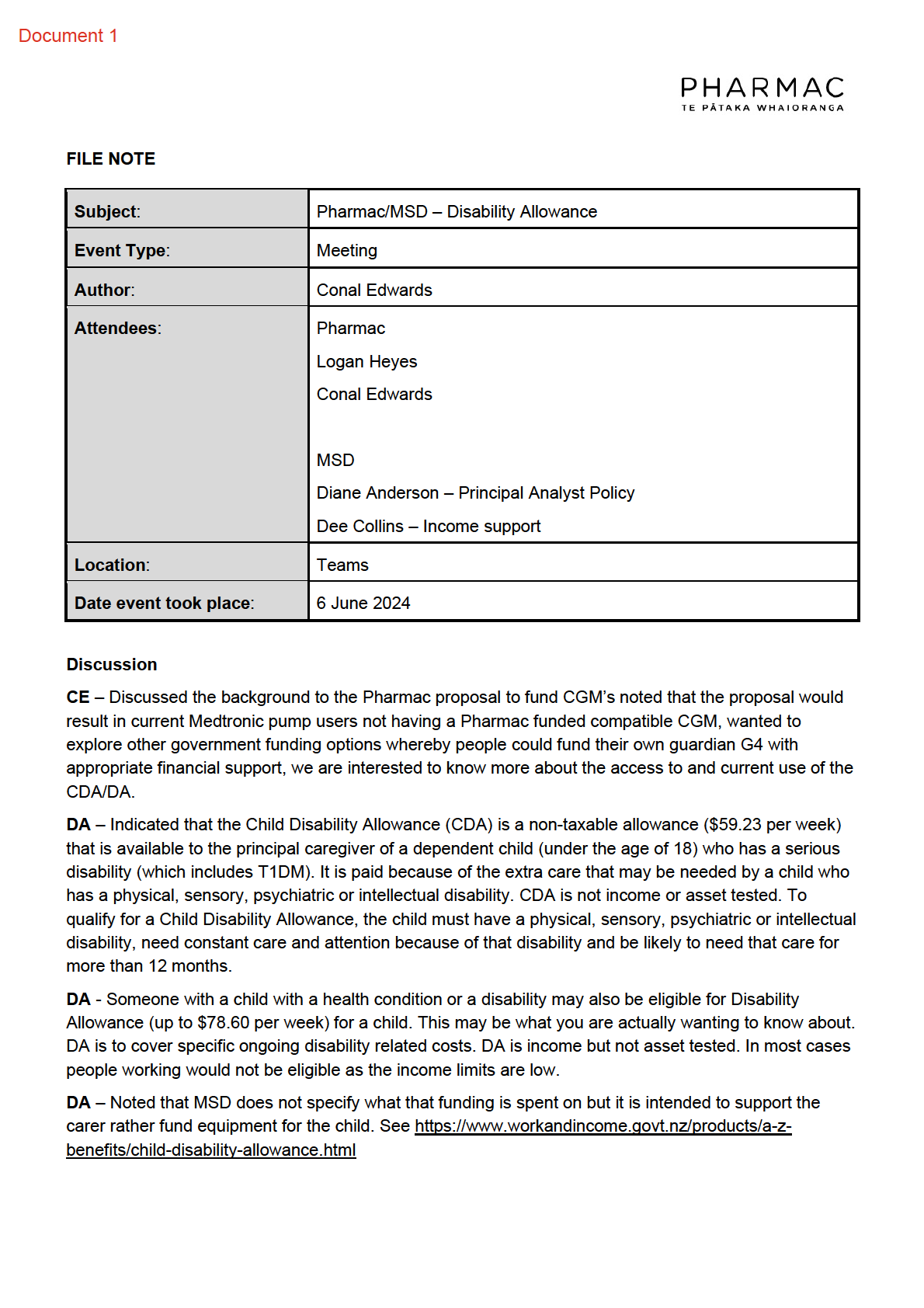
the 1982
Act
under
Released
Information
Official
DA - The cost of buying equipment or other one-off items cannot be included in Disability Al owance
(which is means tested). This is because the costs are not regular or ongoing. Equipment is general y
funded via the health system. Insulin pumps, for example, would be considered equipment and therefore
not funded via DA.
LH – Asked what the number of people would be currently accessing the CDA and using it for the
purchase of diabetes technology.
DA – Referencing a 2022 data set used for another project which broke down Child Disability Al owance
by disability type. The medical descriptions are based upon text parsing of the free text written by
doctors and are only an estimate (compared the work capacity medical certificates where READ codes
are used). In June 2022 there about 43,600 caregivers receiving CDA for a child with a disability. Of that
number diabetes was listed as the reason for about 1650 cases (3.7%). There is no additional detail
available as to what the allowance was spent on.
CE – We have had feedback from diabetes clinicians that a significant number of people are claiming
and using the CDA for the funding of CGM’s particularly in the last 12 months, has there been a growth
in the number of applications for the CDA ?
DA - s 9(2)(b)(ii)
. I’m not
the 1982
sure what the breakdown is for people claiming because their child has diabetes. Normally we just
breakdown the data by whether it is a physical disability, psychological/ psychiatric disability or both.
LH – Thanks for your time today would it be reasonable to assume that MSD are not looking to change
the criteria for access to the CDA/DA in the foreseeable future?
Act
DA - At this stage there are no plans to change the way people access these benefits.
under
Released
Information
Official
Document 2
AGENDA - NZSSD meeting – Diabetes Technology RFP
31 May 2024
9:00 am – 12:00 pm In-Person and via Teams
Pharmac offices: Level 9. 40 Mercer Street, Wellington
In attendance :
Pharmac : Conal Edwards / Michael Chung / Logan Heyes / Casie Hanrahan
NZSSD : s 9(2)(a)
Items for discussion:
1. Specific Issues raised as part of the consultation process (see attached)
2.
Alternative Brand Al owance (ABA – Criteria)
the 1982
a. The following patient groups / conditions have been highlighted as part of the feedback following
the consultation process as part of potential criteria for access to the ABA :
Act
i. People with serious cognitive impairment (eg Elderly / Those with significant
learning disabilities)
under
s 9(2)(a)
– noted that this would be a reasonable factor to include in the ABA criteria with
the caveat that such individuals may be OK with another (funded brand) system if
adequate support was available.
ii. People with significant physical disabilities (eg dexterity / visual impairment)
s 9(2)(a)
– Noted that in a similar vain to the previous item that this might be a factor that
Information
was included with the caveat around support for the individual
Released
iii. People with very high HbA1c levels > 80mmol
s 9(2)(a)
- noted that although the Current literature primarily supports the use of the
Medtronic system in this group, this is likely to be because of absence of evidence
with other systems, as they are technically capable of delivering the same
Official
therapeutic benefit. s 9(2)(a)
advised that it was reasonable to remove this from the
proposed ABA criteria.
iv. Young children
s 9(2)(a)
– Noted that the Ypsopump is suitable for children due to the small size of pump
and remote bolousing facility. Estimates from Wel ington and PN is that 80% of
A1816575
1
young children would currently be on a Tandem pump. Reports from Australia is that
Ypsopump works well in children. The condition of a “young child” is in itself not
sufficient basis for accessing the ABA - but it could be appropriate in conjunction with
other criteria e.g. the cognitive impairment restriction. Patch pump may be
appropriate for some in this group. But difficult category to include. Lots of "young
children" with T1 diabetes so likely to be a significant group size - needs to be
restricted. While there are geographical quirks with Minimed use - much of the
country is comfortable using Tandem in children. Minimed is only pump licenced
from age 0. Ypso = age 1, Tandem = age 6, this licensing is not necessarily
representative of the actual capability of the relevant pump to safely deliver
therapeutic beneft (The licensing aspect is not applicable to the use of such devices
in the NZ context)
v. Difficult treatment non-compliant adolescents the 1982
s 9(2)(a)
- This is a big issue – The Medtronic system may be more appropriate for these
people due to the “set and forget” algorithm. This group = majority of adolescent
Act
clinics so not really an exceptional group. Don't want to include any glycaemic
targets in this criteria for this group. NZSSD - no reason for this group to not at least
under
attempt to change brand. Anecdotal evidence is that there are already people in this
group using the Tandem pump. This group would likely get a 20 mmol reduction from
ANY system, No algorithm is completely set-and-forget, all systems require some
degree of self-management especially around meal-time and exercise. But will still
get *some* benefit even without active self-management. Likely that more targeted
education and support for this group would ease the burden of change.
vi. People with problematic social circumstances (low SES)
Released
Information
NZSSD - Appropriate transition management plan would be sufficient to manage this
group of patients. No reason for this group to NOT change, just that change may be
more difficult. Pharmaco have discussed funding phones for patients without phones
which would reduce the obstacles somewhat.
Official
vii. Intolerance of adhesives on funded CGM options
NZSSD – May be reasonable to keep this as a criteria, adhesive intolerance is rough
however generally it can be successfully managed. May need to include a trial
period. Freestyle Libre 2 is much less allergenic than the Libre 1. People have had
reactions to the 1 but not the 2. Companies need to provide comms about how they
are working to improve al ergenicity of products, the other brands are no less likely to
A1816575
2
demonstrate dermatological tolerance and it may just be a case of adapting how the
CGM’s are used.
viii. People with significant Mental Health issues
NZSSD - Up to 30% of people with diabetes have anxiety, depression or diabetes
related distress of some level. May be appropriate to seek information directly from
Mental health professionals in these situations. Hard to define this group but may fall
into umbrella of other criteria.
ix. People of significant weight > 140 kg
NZSSD – This is not a basis for accessing a non-listed pump as such.
x. People who require a significant daily insulin amount > 160 mg ?
the 1982
NZSSD – Potential patient groups who may fall into this category includes Pregnant
women on high daily doses of over 100 units a day, People who are insulin resistant.
Act
The YpsoPump smal insulin cartridge may be an issue for people with high insulin
doses especially young kids who get sent to school and whose cartridge may run out
under
during the day. This is not a criteria by itself but could be included with other criteria.
Insulin resistance = pregnancy, adolescents, and inherited resistance. Medtronic
algorithm probably stronger for those with insulin resistance. But significant factor in
success of algorithm is the quality of initial setup.
xi. Other Reasons?
NZSSD – Some people have highly physical jobs so they may struggle with the logistics
associated with a conventional tubed pump, these types of cases would need to be
Released
Information
considered in relation to other extenuating circumstances, the number of people who fall
into this category would likely be quite small.
b. For whom is a trial of a funded option not appropriate ?
i. What is a reasonable trial period ?
Official
NZSSD - Very few groups for whom trialling a proposed brand would not be appropriate
c. For what reasons are the proposed devices not appropriate ?
d. Can any of the criteria be adequately addressed through appropriate training and education ?
3. Eligibility Criteria
a. Is the proposed eligibility criteria/wording reasonable ?
A1816575
3
NZSSD - G6/G7 criteria points 2.2-2.3 = open to interpretation resulting in inequities to access.
Remove these criteria. Reword 2.4 to pre-conception. Want women going into pregnancy with
optimal control
Potentially reword to "where extra alarm functionality may benefit due to severe unexpected
hypoglycaemia or variation in glycaemic control". Risk that this may result in everyone going for
the G6/G7
Replace pancreatectomy with pancreatic failure. Predictive alarms are useful for the hypo-
unaware
b. Are there any other groups that should be reasonably included (while stil meeting the original
intent) e.g. people with pancreatic insufficiency, gestational diabetes, rare metabolic conditions
NZSSD - Gestational diabetes = high risk group but only use this for short period of time.
Diagnosed at 24-28 weeks, usually deliver at 39 weeks. Stop CGMs immediately post delivery.
Max 6 months but this would be very unusual. Typical duration would be for 3 months or less
the 1982
This would need to be part of the SA criteria.
Renewal criteria = has previously had gestational diabetes and has been diagnosed again.
3000 people with gestational diabetes per year, does not include pre-existing diabetes
Act
c. Initial and renewal criteria ?
under
NZSSD - Concern about "any relevant practitioner" in initiation insulin pump criteria. Also amend
pancreatectomy to pancreatic failure
Suggest to include in comms/criteria that the expectation is that onboarding would be in
secondary care.
Helpful if primary care can do renewals for pumps/consumables
Information
Consider replacing 3.1.2 criteria with a blanket "in the opinion of the specialist, would benefit
Released
from an AID system"
Consider keeping 1 and 2, and just removing box 3.
Remove requirement for objective improvement from renewal criteria
Consider making lifetime approval for pumps, consumables and CGMs.
Official
Consider extending initial and renewal pump criteria to 6 months.
4. Brand specific issues :
a. What would enable greater acceptance of the Ypsopump option ?
A1816575
4
5. Statement regarding Proposal:
“The proposal would provide significant benefit in the glycaemic control for all Type 1 diabetics
which wil delivery substantial benefits to the wider health system”
6. Transition and Implementation
a. Current other agency financial assistance programs (CDA / HNZ Carer Support)-need to ensure
assistance remains in place for Medtronic users during transition period :
i. What proportion of insulin pump users currently have AID access ?
ii. Would a significant number of people opt for a funded CGM without AID system option ?
b. Which patients wil be prioritised for insulin pump onboarding ?
c. What is the current backlog for Insulin pump onboarding in 2ndary Care ?
i. Does this vary significantly by region ?
NZSSD - Huge backlogs, about 20% of patients currently on pumps so up to 16000 potential patients
the 1982
Need to explain to Te Whatu Ora why secondary care needs resourcing to support the
implementation of this proposal
Act
Some regions wil need primary care to refer patients back to secondary care because
secondary care wil have no visibility of these patients
under
Secondary care must see referred patients within 4 months
d. What specific support does 2ndary Care need to implement (and from whom) ?
NZSSD - Wil need specific training for Ypsopump but al centres would already be familiar
with Tandem and Control-IQ
Released
Information
Official
A1816575
5
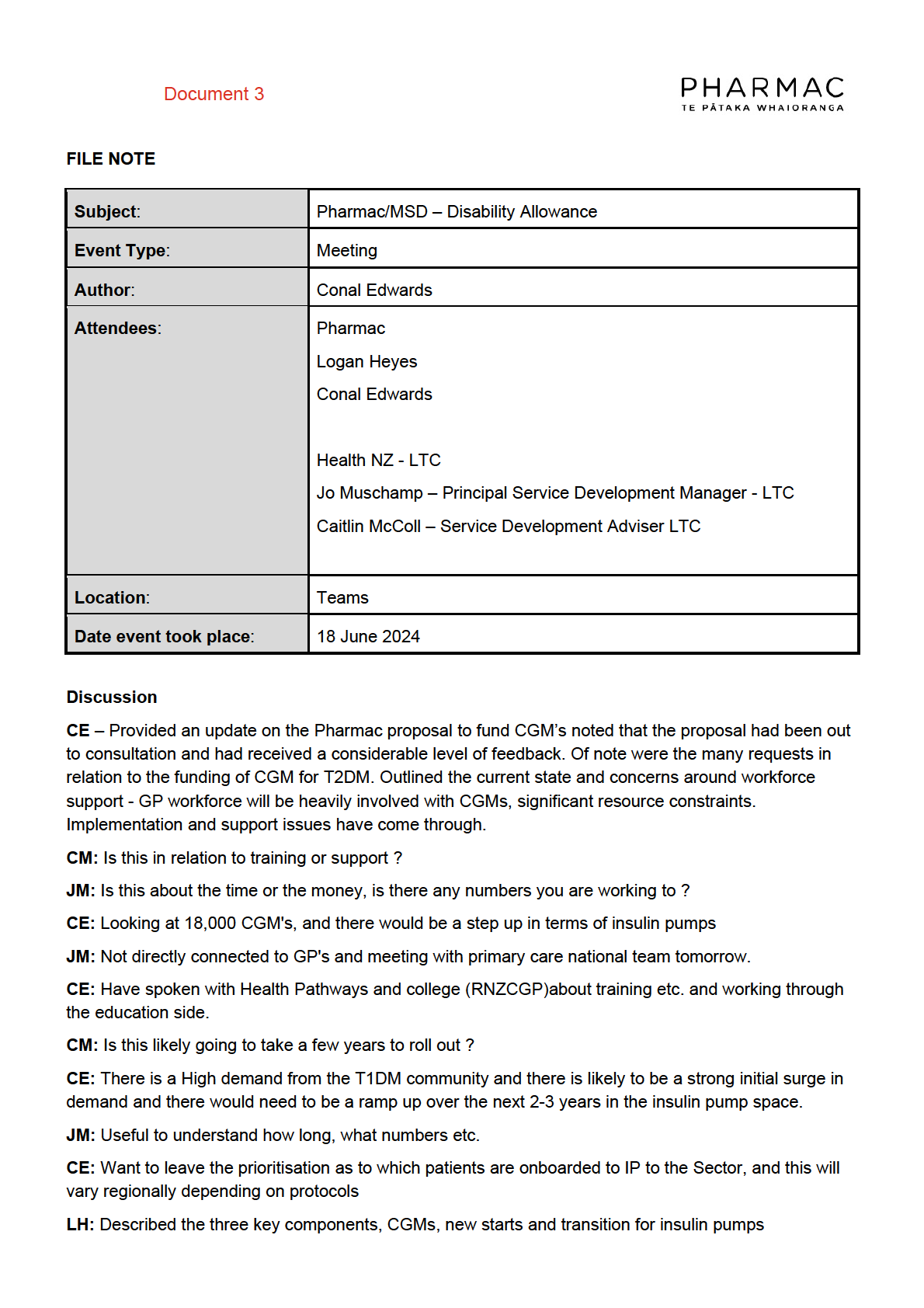
the 1982
Act
under
Released
Information
Official
CE: Have been working with Diabetes NZ. They wil do a lot of the messaging at the consumer level.
Suppliers wil have a lot of information hosted on their websites
JM: We hold contracts with Diabetes NZ
CE: The roll-out is likely to be very resource constrained in the initial periods until the diabetes services
can achieve some efficiencies
JM: Do you have contacts in Secondary care ?
CE: Wil put you in touch with NZSSD so that we are talking with the same people
LH: Significant regional variation, for these reasons have reached out to the Diabetes Chch
CM: What are the plans for Type 2 patients?
CE: Some of the feedback received was in relation to this group. We aren't able to consider this at this
time but are interested in considering this when we have an application.
LH: Wil send through some information to support conversations with primary and secondary care.
CE – Indicated that the target 1st July list date was no longer feasible, and the plan was to delay the
listing until later in the year allowing time to resolve the myriad of points raised during the consultation.
the 1982
Act
under
Released
Information
Official
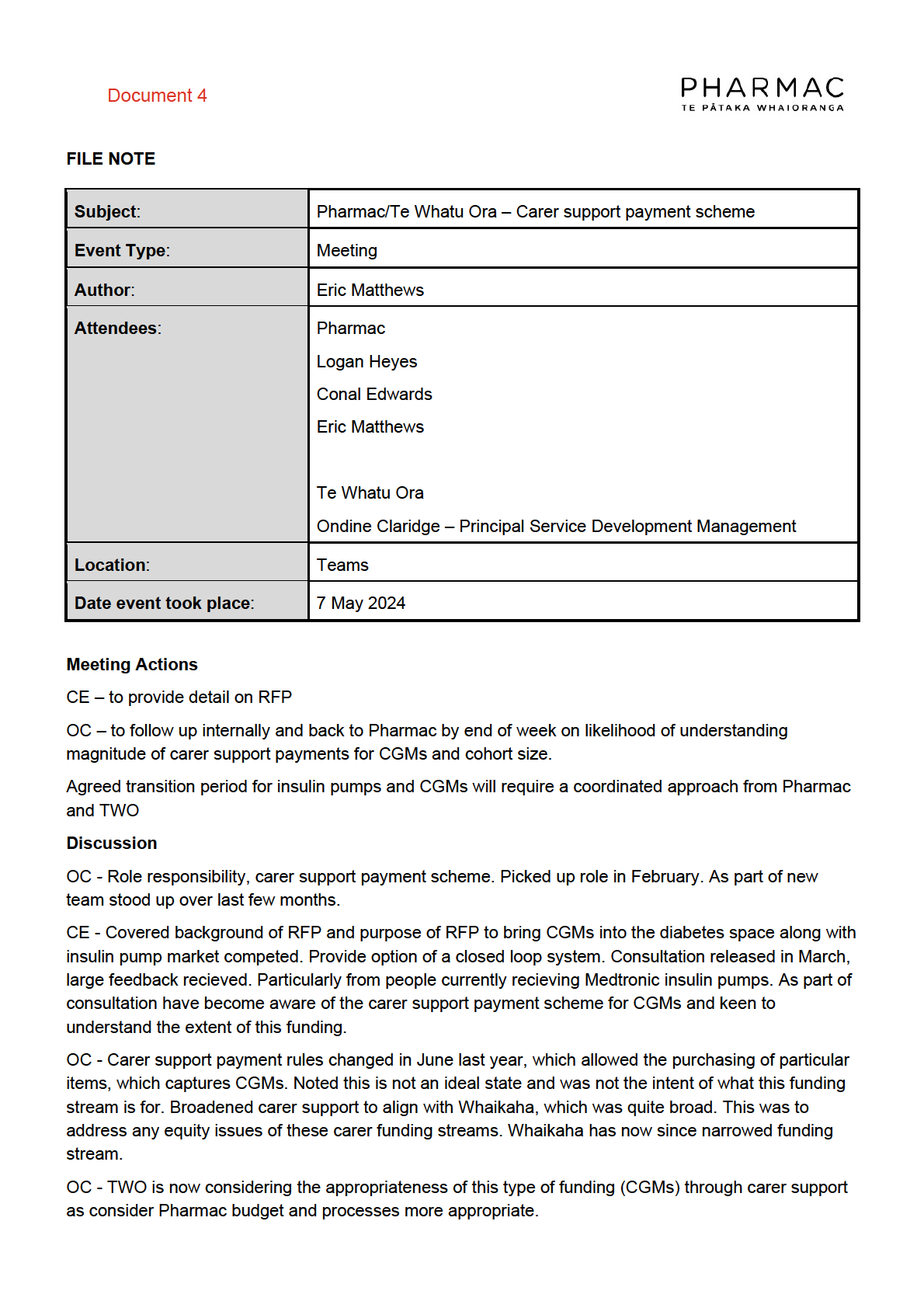
the 1982
Act
under
Released
Information
Official
CE - Noted proposal is to not continue to fund Medtronic as they were not a preferred bidder in RFP
process.
LH - Noted broadened carer support funding has effectively created a bridging program to CGM. This
has enabled people to have automated insulin delivery systems and created an environment that is
much more dif icult to manage under Pharmac proposal. This represents a change from the initial
understanding of the proposal, and so keen to understand the extent of this cohort size and outlined the
need for an orderly transition to Pharmac funded pumps and CGMs.
OC - Drafting an email to finance team and trying to understand the size of the cohort and funding
scheme for CGM. Noted issue is when funding was broadened, the monitoring systems were not
upgraded and concern of the difficulty to understand the funding streams, specificity and scale.
OC - would be good to get a bit of background on some of the complexity of RFP and proposal.
CE - Can provide. The key thing is that we now have a group of people who are much more hesitant to
switch to the system proposed under the Pharmac proposal. From our perspective, it would be great if
carer support would enable continuation of funding for the duration of the transition period.
CE - Clarified what pumps are funded currently – MiniMed (Medtronic) and Tandem. Medtronic is
proposed to be discontinued.
the 1982
OC - So ultimately the CGM funding via TWO would need to cease at some point. We had been
considering the appropriateness of this funding already.
CE - Yes, however we would consider this would be appropriate to continue to end of transition period.
Act
OC – Understand the need for an orderly transition here for people.
under
LH - Noted split of current pump market. Issue isn’t those receiving the Tandem compatible products.
But the Medtronic people.
OD - We don’t know the volumes at this time, it could be a very small group of people, however very
uncertain on the magnitude. Went to a carer alliance meeting and diabetes NZ were querying the
Whaikaha funding narrowing. Was not aware of this usage and raised concern that this funding avenue
was not intended for this.
CE - Also aware that WINZ is another funding stream for CGMs, perhaps targeted at under 18s.
Complex with potentially three different agencies funding these devices to some degree.
Released
Information
OD - Clarified carer support program is for medical y disadvantaged children, across the life course. So
indicated it could be a young cohort. Do you want Pharmac to be only funder of these products?
CE - that is what we had envisioned as part of RFP, however alternative funding streams have come to
light as part of consultation.
OC - Questioned whether there is a difference in quality of pumps and CGMs?
CE - noted clinical advice received of equivalence between products, however there is consumer
Official
preference for products and products are strongly marketed. Noted Canterbury and Southland in
particular has high use of Medtronic. Therefore, there is a need for an orderly transition that aligns with
the duration of the transition period.
OC – Understand the need for an orderly transition to proposed pumps and CGMs. Noted follow up
internally on the information required by Pharmac to understand magnitude of CGM funding via carer
support, and noted the urgency for this. Acknowledged this information review is really needed right
away. Noted the mechanism to review wil require manual review of invoices.
LH - Queried whether the invoice information is just a bulk payment, or whether the invoices had info on
purchasing information.
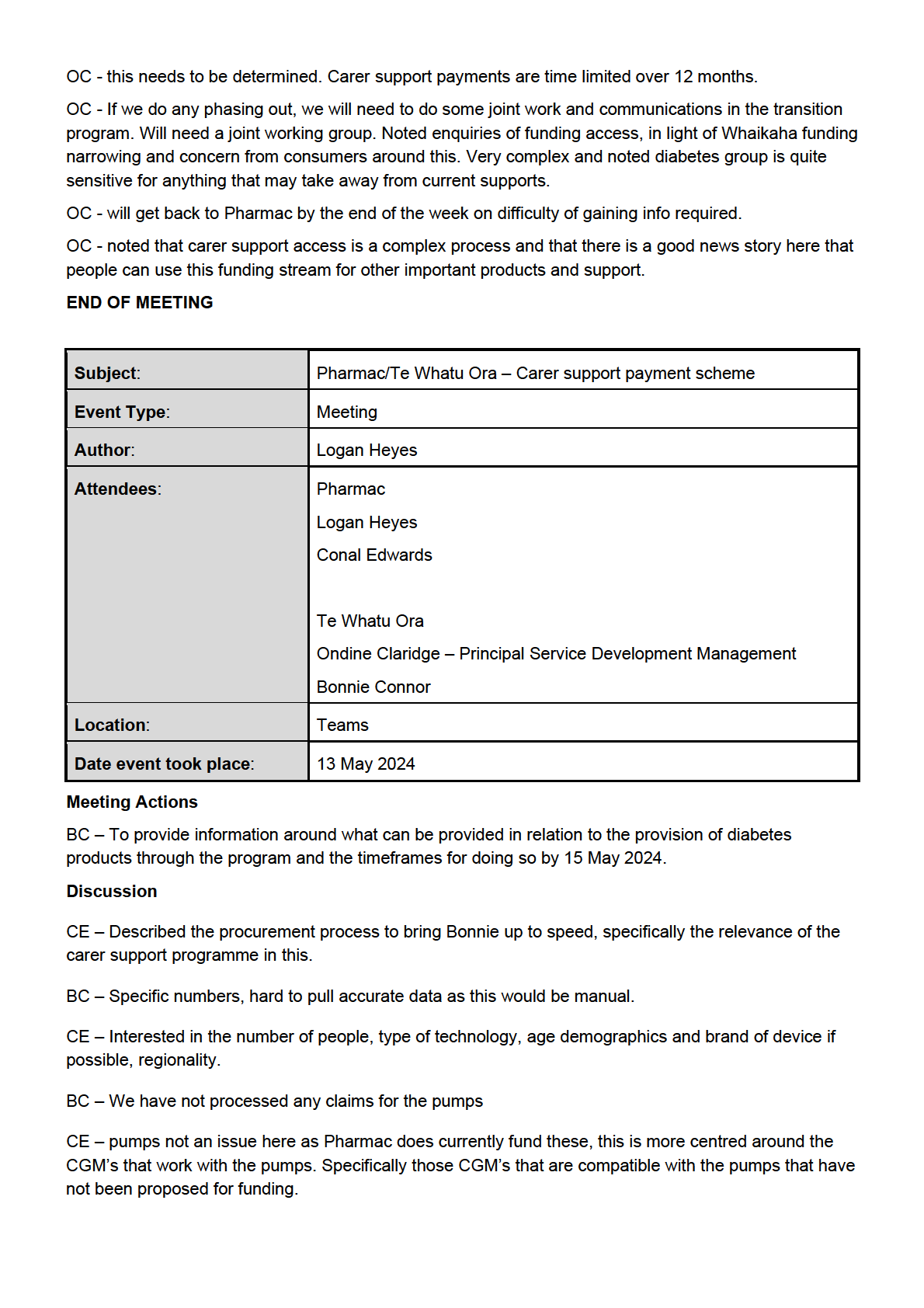
the 1982
Act
under
Released
Information
Official
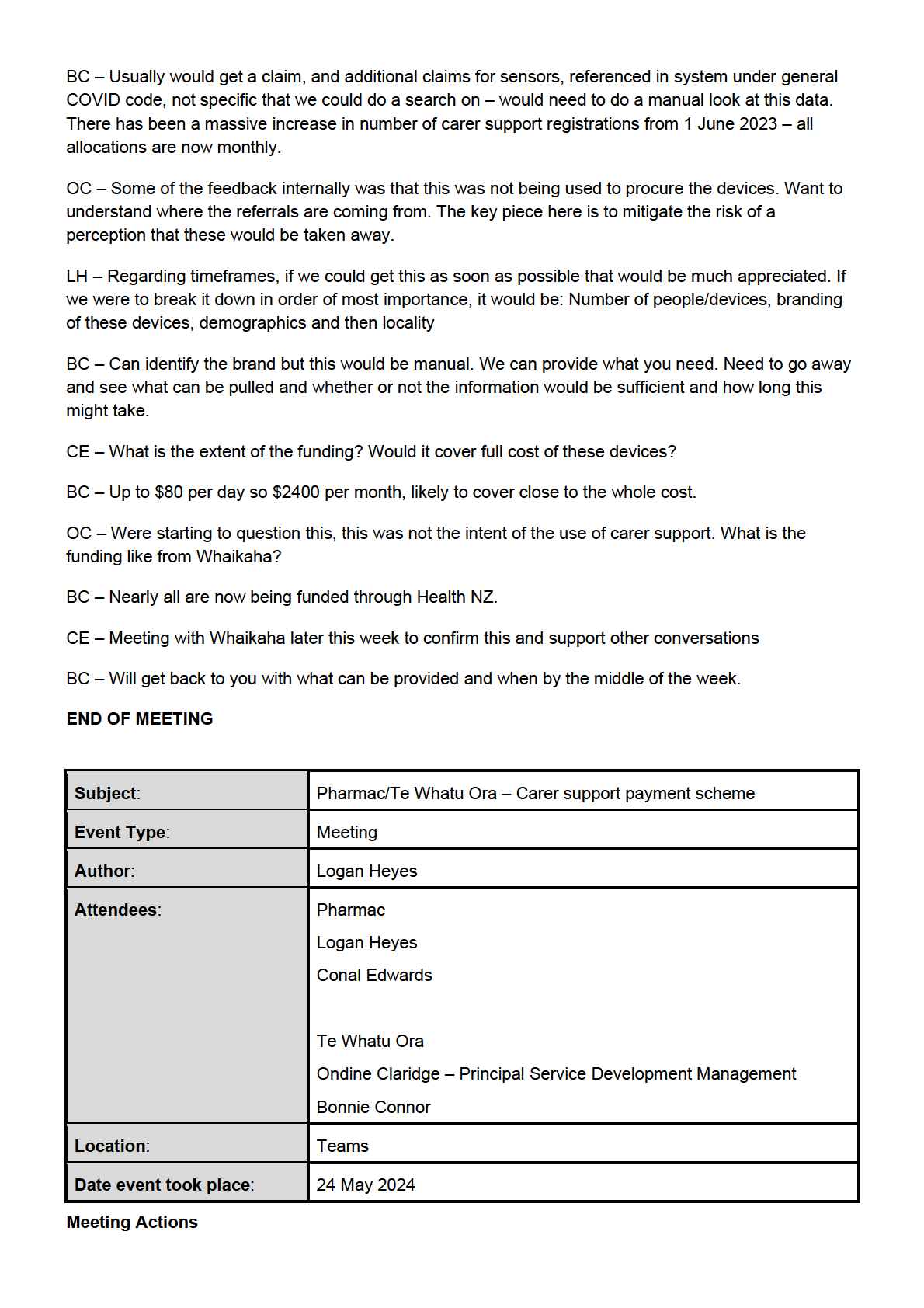
the 1982
Act
under
Released
Information
Official
BC – To provide detailed information about the use of the scheme for people with Type 1 diabetes,
including the specific products, total costs and total patient numbers
Discussion
BC: Since June 2023, we can see a range of diabetes equipment that has been claimed for as part fo
the carer support scheme – this includes but is not limited to: Dexcom G6 subscription and sensor,
Dexcom G7, Intermed Guardian 4 and transmitter kit, Freestyle libre 2 sensor, All of which have been
funded by Health NZ
BC: No pumps have been claimed for under this scheme
CE: Wouldn't expect claims for a pump
LH: Do we have any idea of what this looks like in terms of how many claims and for how many people
BC: Would estimate that this would equate to around 600 claims or so (not certain – but an estimate) for
clients under certain disability group (under 18)
OC: Do we have any idea of what this looked like before compared to after June 2023
the 1982
BC: These figures depend on how quickly they process these claims, rather than when they are
submit ed, so this wil be difficult to ascertain
LH: Need this to remain open to support the transition, however acknowledge that a large proportion of
this would now transition to Pharmac funding.
Act
OC: Some will need this to continue, most devices wil be listed on the Schedule. We have a problem
under
with the increasing cost of the carer support scheme. Would need to specify that the ones that are listed
on the Pharmaceutical Schedule would not be part of the carer support scheme moving forward and
move towards alignment with the Schedule rules.
CE: Work with you to communicate this – also talking with MSD about their Child disability allowance
which may be being used for this as well
BC: Wil look to provide how many people from 1 July 2023 have commenced this, roughly estimate the
cost that may shift to Pharmac. Note that this may be phased shift of the cost, some people
END OF MEETING Released
Information
Official
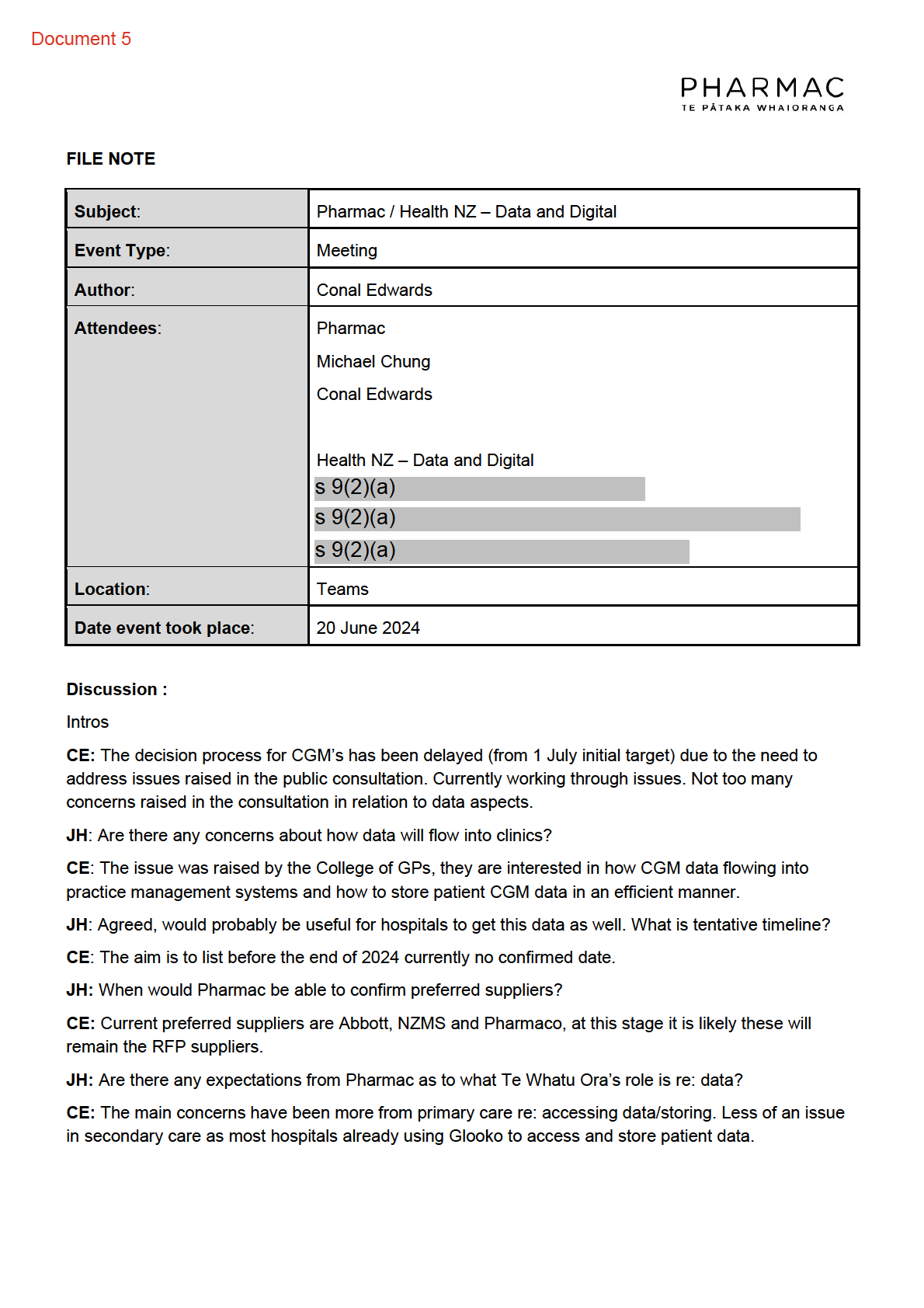
the 1982
Act
under
Released
Information
Official
JH: HNZ need more info from Pharmac as to what its expectations are. Once we have this information
about Te Whatu Ora’s expectations, we can put a business case forward to try and get some funding to
invest in the data management solutions. HNZ need to do a technical/security review of Glooko, nothing
has been done about this to date.
CE: secondary care has been less concerned about data management. Reiterating that major concern is
coming from primary care.
JH: who currently pays for Glooko? Aware that its being used. Who wil be responsible for installing
security patches?
CE: suppliers
JH: can you provide contact details of the suppliers so we can liaise directly with them. Also want
information about whether CGMs wil be funded for use in hospitals?
MC/CE: The listing wil be for community use only at this stage.
JH: Christchurch want to use it for monitoring TPN patients in ICU due to emerging evidence.
CE : It is likely we wil receive additional funding applications for the use of CGM’s in different patient
groups / settings
the 1982
Act
under
Released
Information
Official
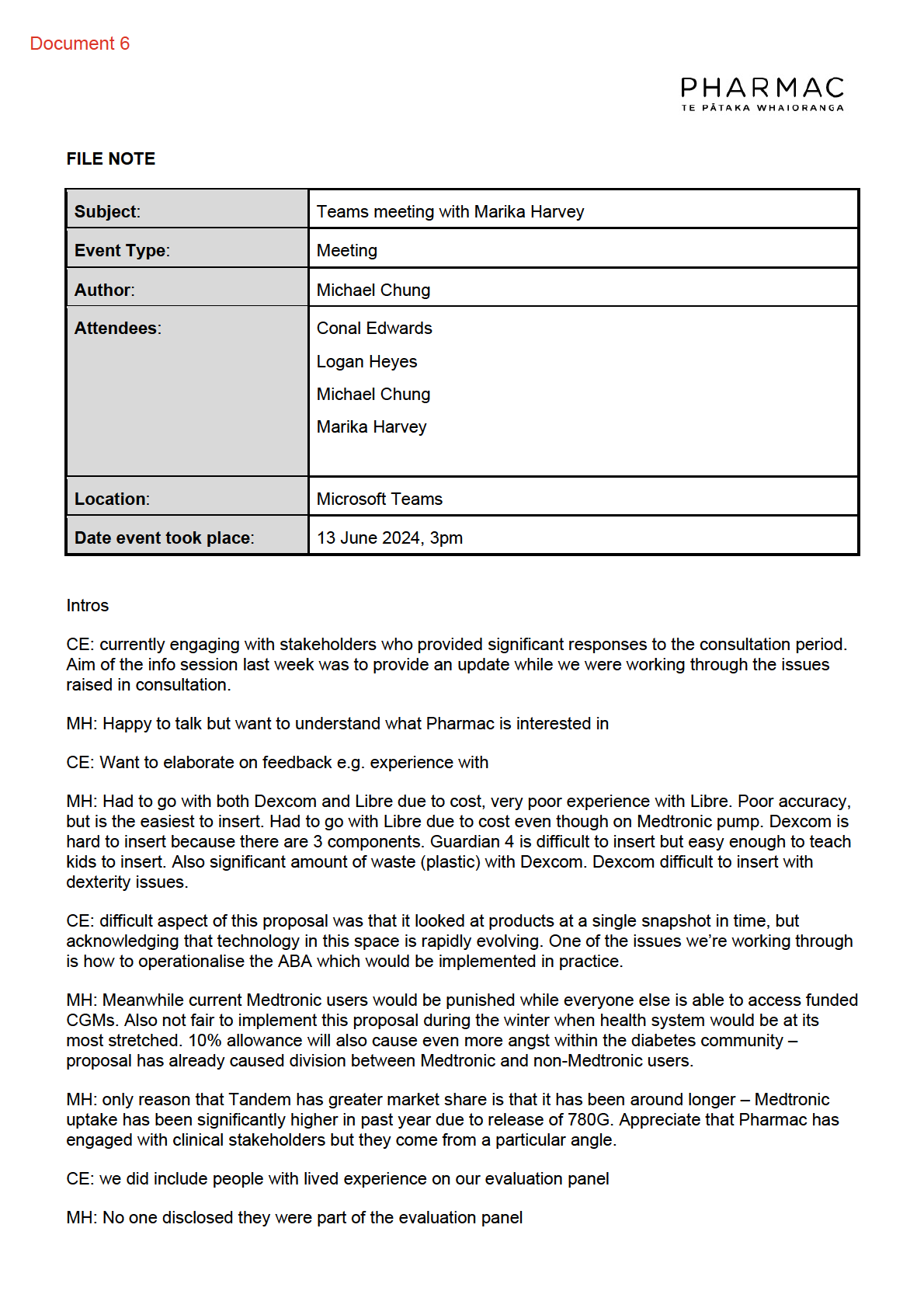
the 1982
Act
under
Released
Information
Official
CE: participants were subject to confidentiality agreements which may explain why people haven’t
disclosed. However, we do acknowledge that the endocrinologists have a very different perspective.
MH: personal experience with Abbott and Dexcom is that you don’t get faulty sensors replaced. Have
only had faulty sensors replaced successfully by Medtronic. Medtronic also supplies free transmit ers to
people whose current transmit ers are starting to die. People are concerned because the YpsoPump is
unknown in NZ, community cannot understand why Pharmac would choose to dump a known system
CE: Have to balance technology with budgetary position.
MH: Medtronic is super hands-off which allows people to live their life as normally as possible. Tandem
only auto-corrects once an hour which requires significantly more intervention from the users. 10% is a
very small percentage and I can foresee that this would be taken up mainly by kids and elderly.
CE: Typical ABA is only 5% but we realised this process would need a higher allowance. Advice
received is that 10% would be sufficient. Our intent is not to restrict people from accessing an alternative
brand if the other options do not provide the appropriate control.
MH: convinced that there wil be suicides if MiniMed 780G is delisted. Type 1 diabetes involves mental
health issues as well as being a chronic health condition.
the 1982
LH: fully appreciate that while we can empathise with your experience, there is no way for us to fully
understand your lived experience. Really grateful for taking the time to share. And is dif icult for us to
listen to your feedback but we also need to come up with a proposal that would benefit the greatest
number of people.
Act
LH: How long have you been on upgraded 780G? under
MH: Since February 2023, prior to that using Dexcom/Libre + injected insulin.
CE: through feedback we understand that people have been accessing funding via alternative funding
streams e.g. child disability allowance.
MH: Age group concerned about = adolescents and young adults who would no longer qualify for CDA.
LH: lots of feedback received highlighted the fact that this process is dif erent to other situations, so
really important for us to ensure we have a robust proposal. But obviously can’t disclose where we’re at
Information
currently. Is there a significant improvement in glycaemic control upgrading from 770G to 780G?
Released
MH: huge improvement, 780G is not even comparable to 770G. Community group = most people with
99%+ TIR. Personal experience from prior to Medtronic was only getting 2-20% TIR. Medtronic doesn’t
let people get into big spikes because it adapts every 5 minutes. Ypso and Tandem corrections aren’t as
adaptive as Medtronic. Menstrual cycle has massive impact on glycaemic control – strength of Medtronic
algorithm is that it has learned to adjust insulin delivery every 28 days for cycles. Also adapts to
seasonal patterns e.g. increased insulin delivery in summer vs winter. Medtronic algorithm can also
Official
differentiate between when I am on a day or night shift.
CE: thanks for time, always valuable for us to hear directly from patients and users of the technology.
We wil continue to provide updates on website about timeframes.
MH: wil there be another formal consultation phase which would delay this even further?
CE: we have already received a significant amount of feedback, intent is not to consult again. We do not
want to delay this any more than we need to. We’re committed to delivering a proposal for the type 1
community.
LH: agree that intent is to resolve issues as quickly as possible so we can present a proposal that is as
robust as possible. Thanks again for your time.
Meeting end.
the 1982
Act
under
Released
Information
Official
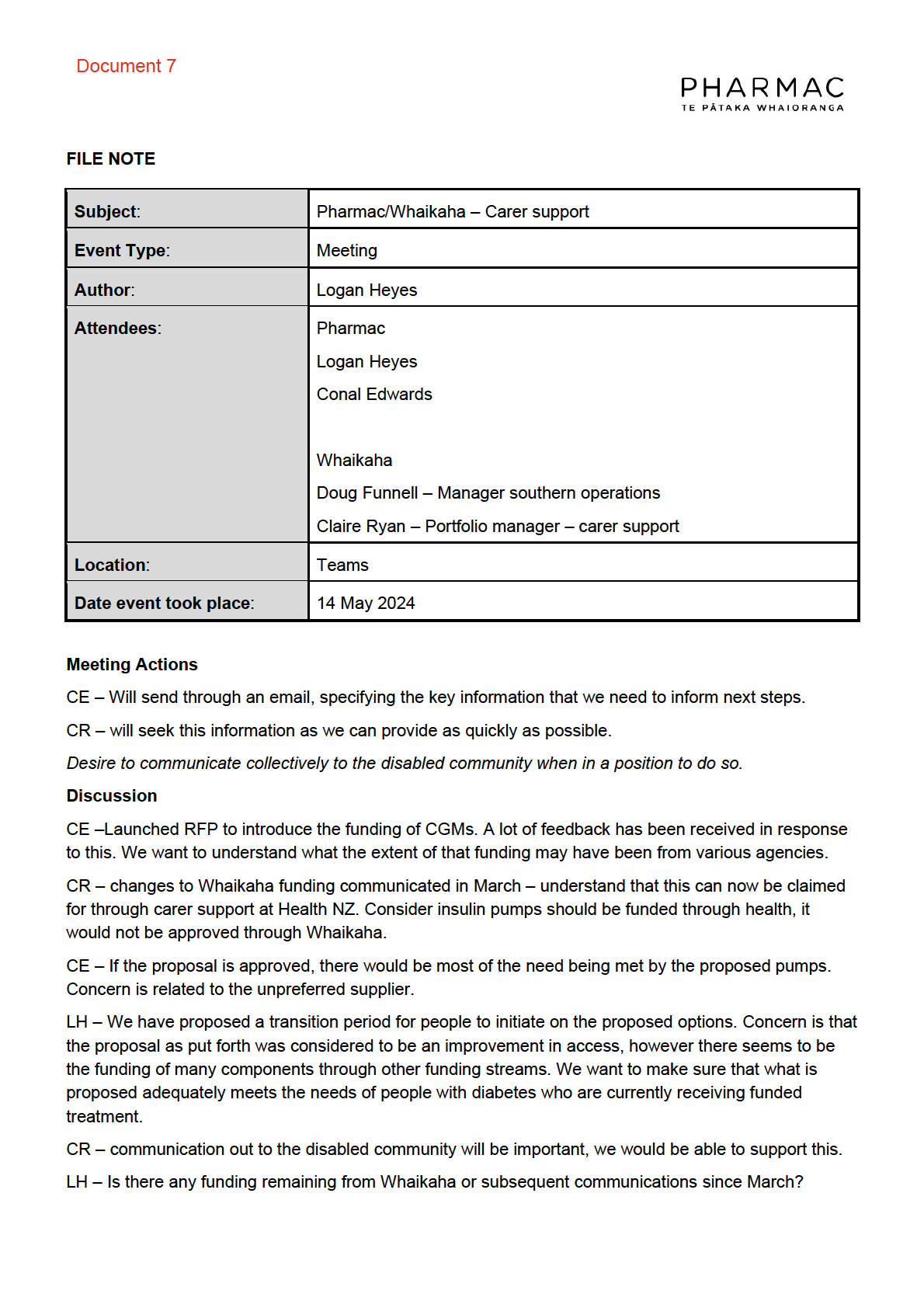
the 1982
Act
under
Released
Information
Official
CR/DF – Purchasing rules for equipment have changed and understand that there is much greater
numbers of purchases in the TWO area. Would honour commitment to funding, understand that this is
primarily insulin pumps, imagine this is likely small numbers.
CR – Some will have funding through both carer support mechanisms as there are dif erent rules under
each. Purchasing rules have changed at Whaikaha and this impacts Health NZ carer support.
CE – seeking to expand access to insulin pumps and fund CGM’s for the same population. Want to
understand the use of certain brands of pumps, consumables and CGMs and the extent that this is
continuing.
CR – We wil see what information we can pull together about the funding of diabetes equipment – what
timeframes are you working towards? It is uncertain what the format of this would look like, may be
anecdotal, but wil share what we can.
LH – We are working to very short timeframes and we need to work very quickly to understand and
address such concerns in a timely way.
CE – Wil send through an email, specifying the key information that we wil be requesting.
under the
Released
Official Information Act 1982
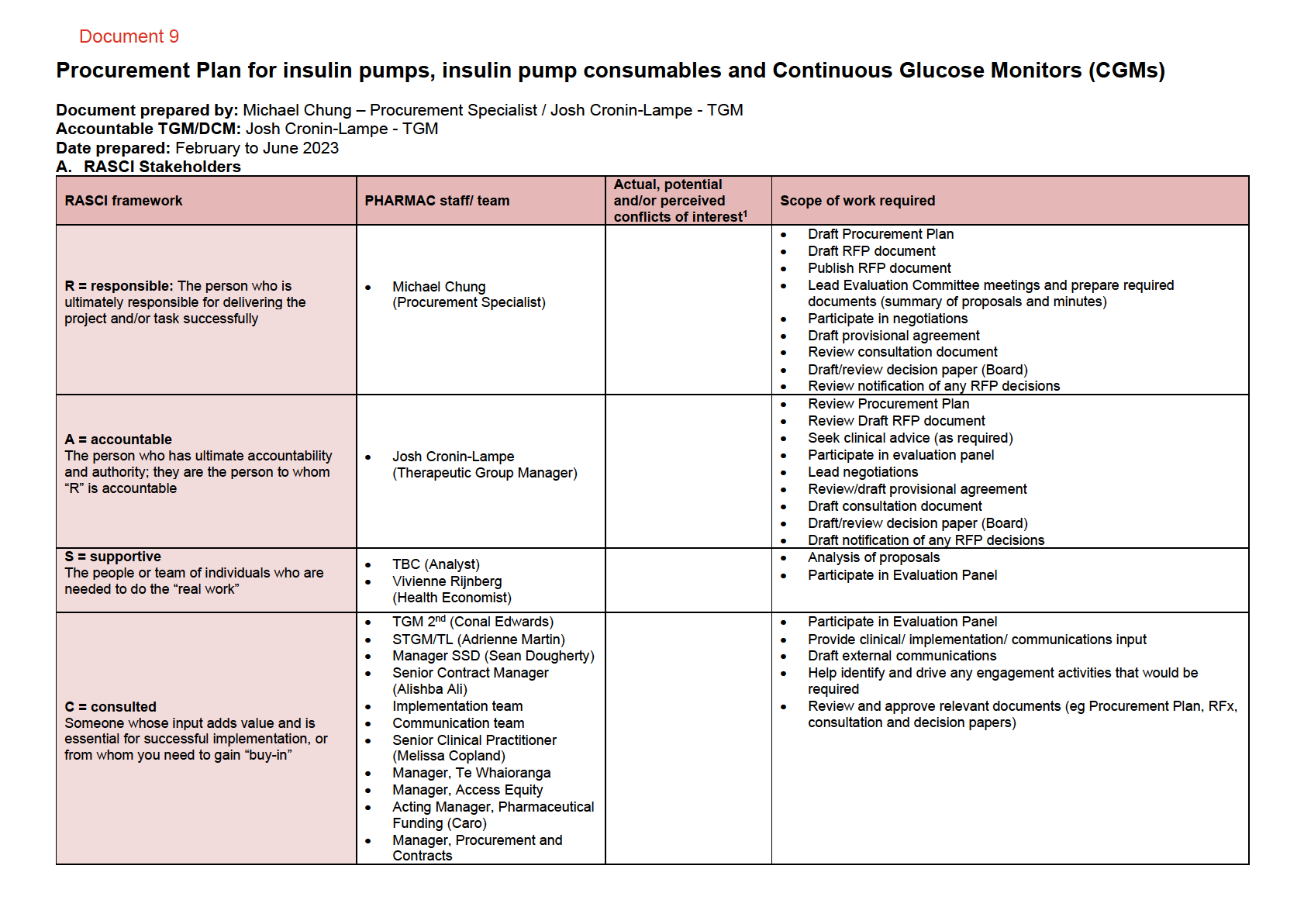
8
Released under the
Official Information Act 1982
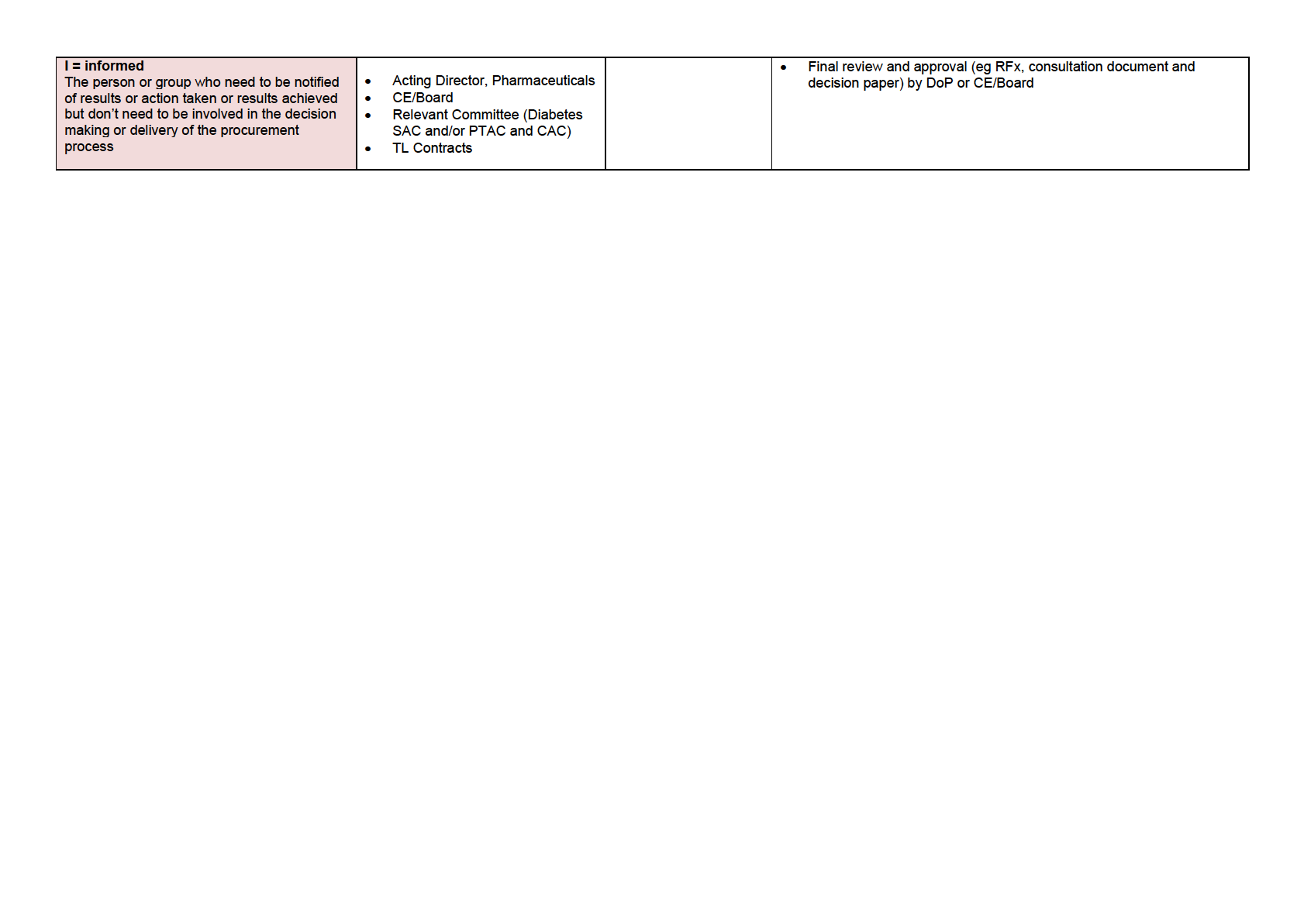
the 1982
Act
under
Released
Information
Official
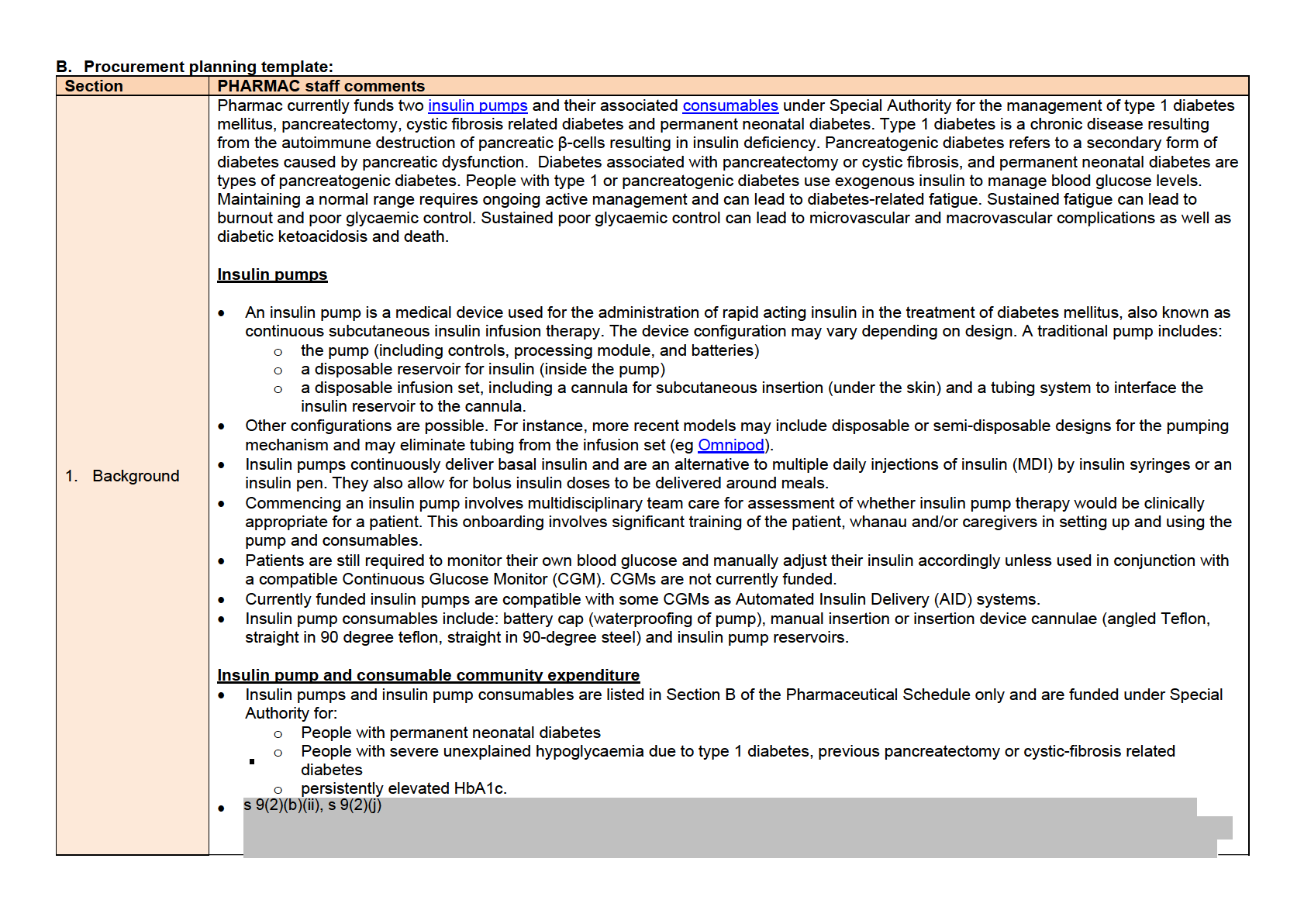
the 1982
Act
under
Released
Information
Official
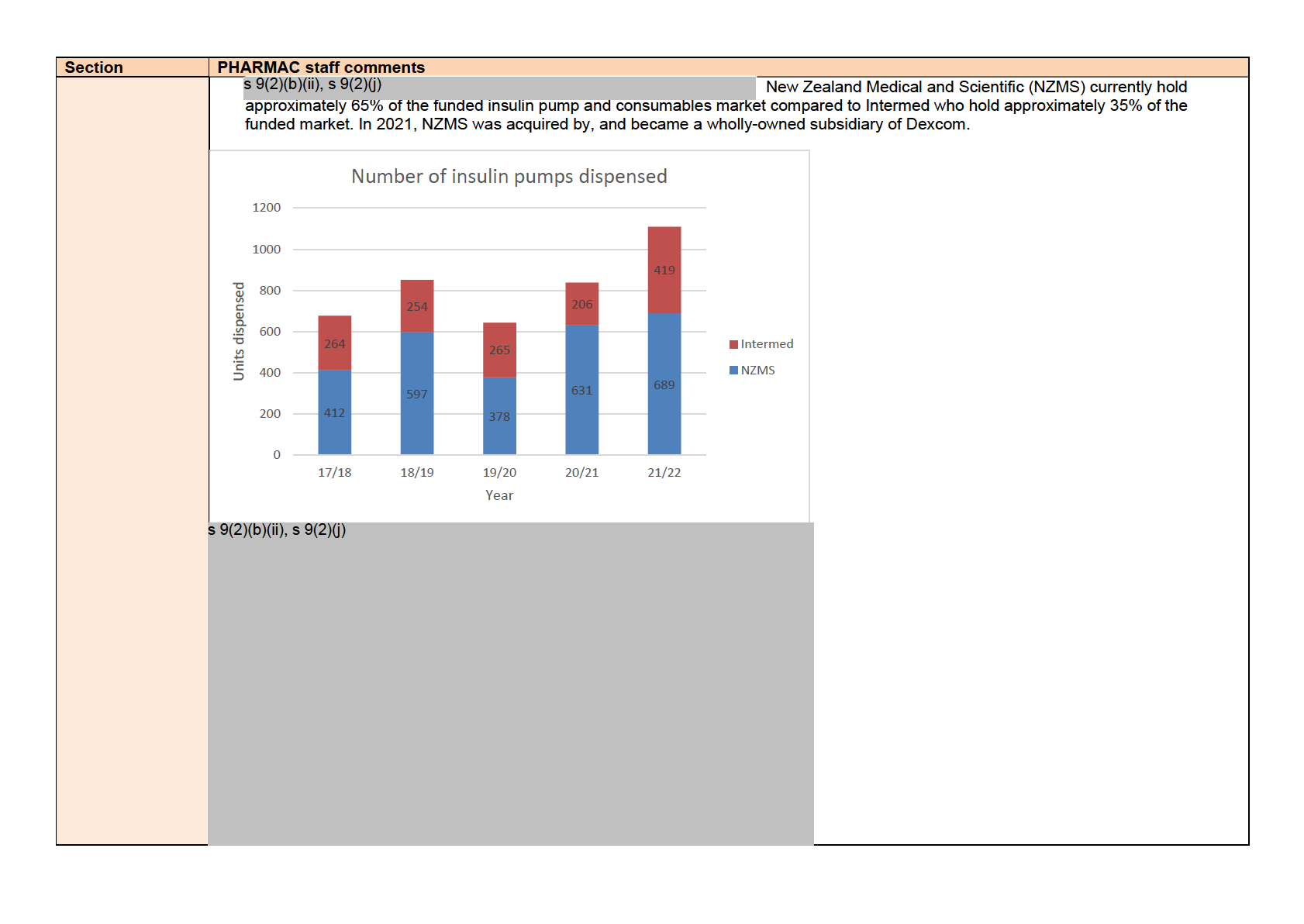
the 1982
Act
under
Released
Information
Official
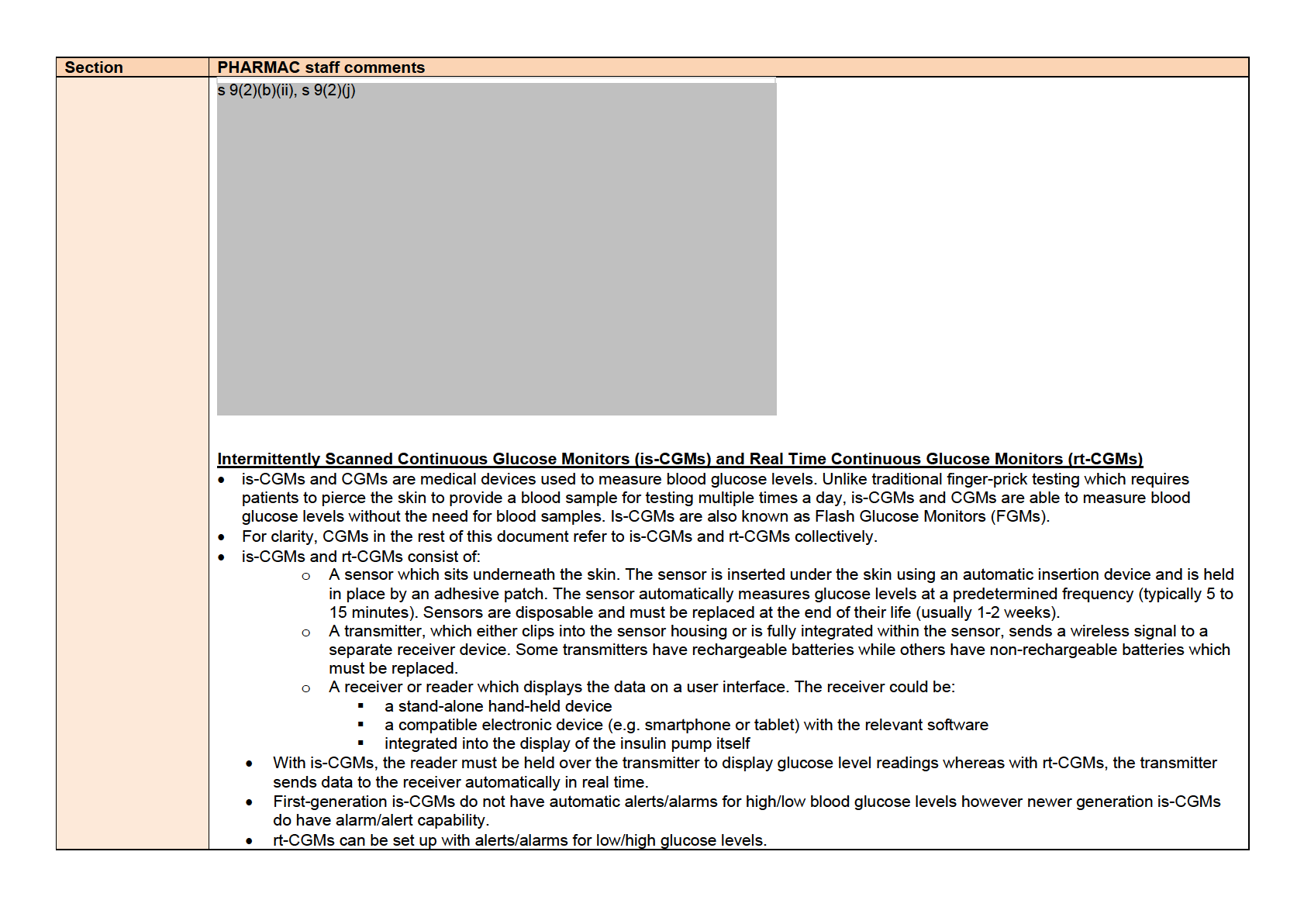
the 1982
Act
under
Released
Information
Official
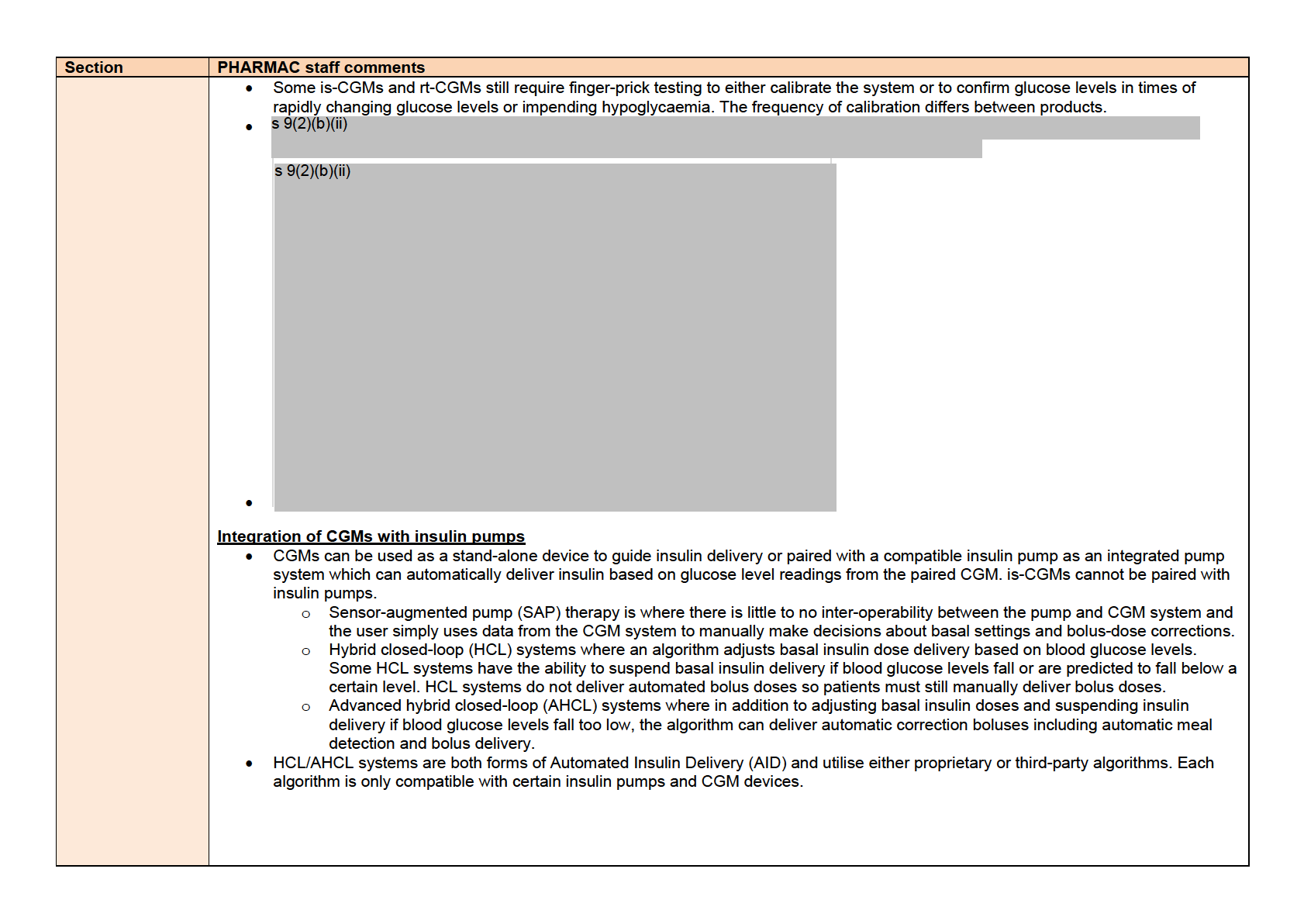
the 1982
Act
under
Released
Information
Official
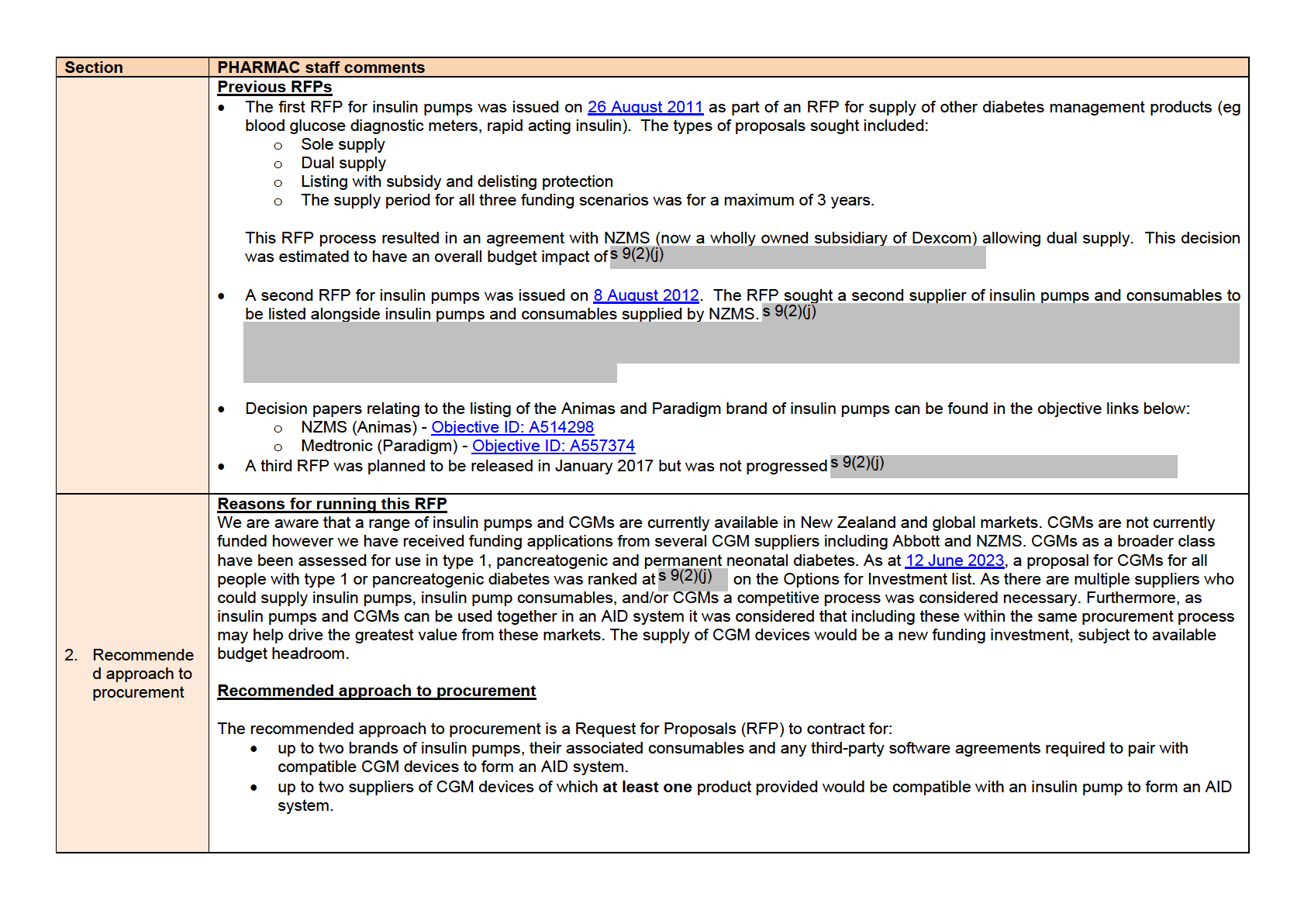
the 1982
Act
under
Released
Information
Official
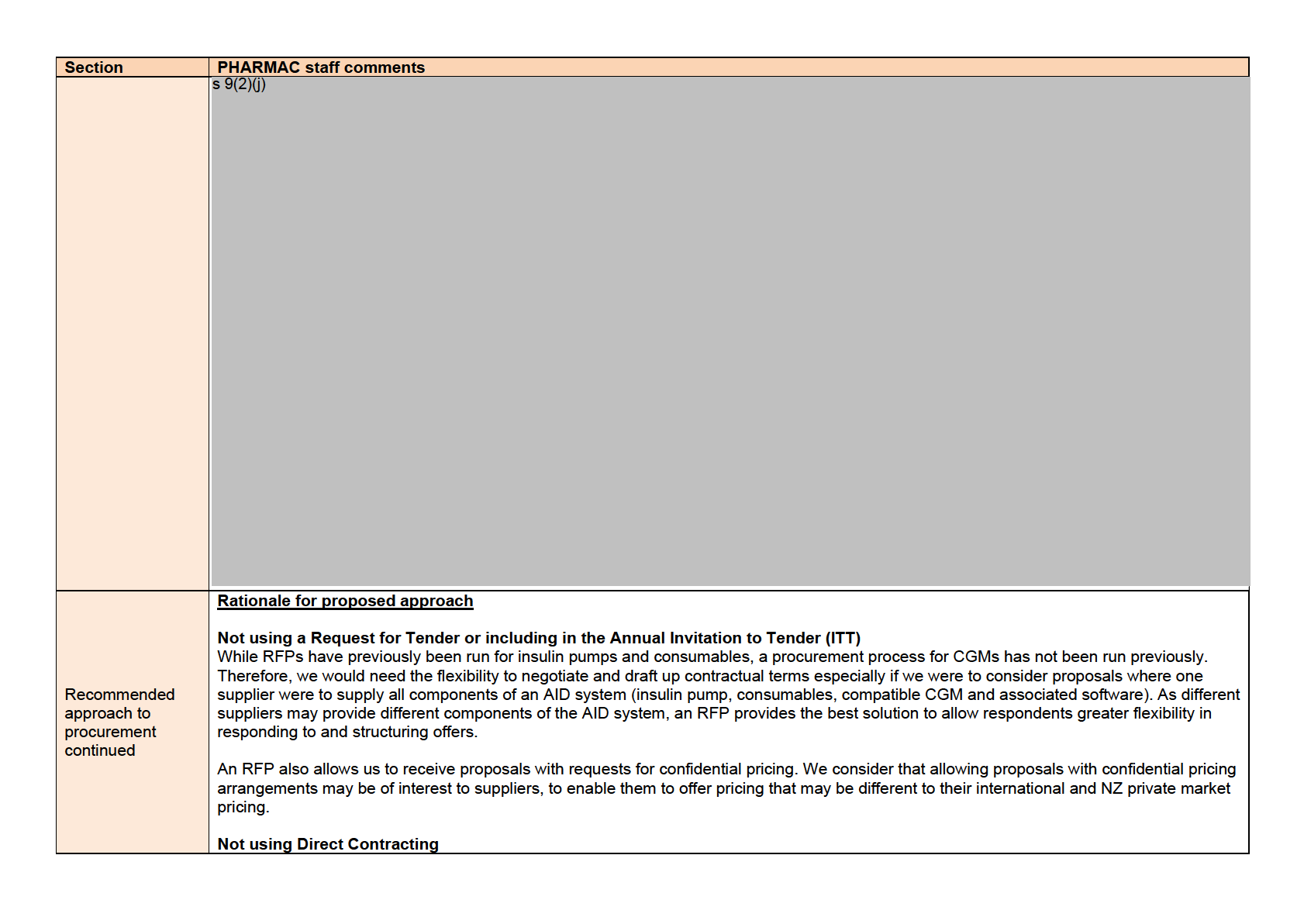
the 1982
Act
under
Released
Information
Official
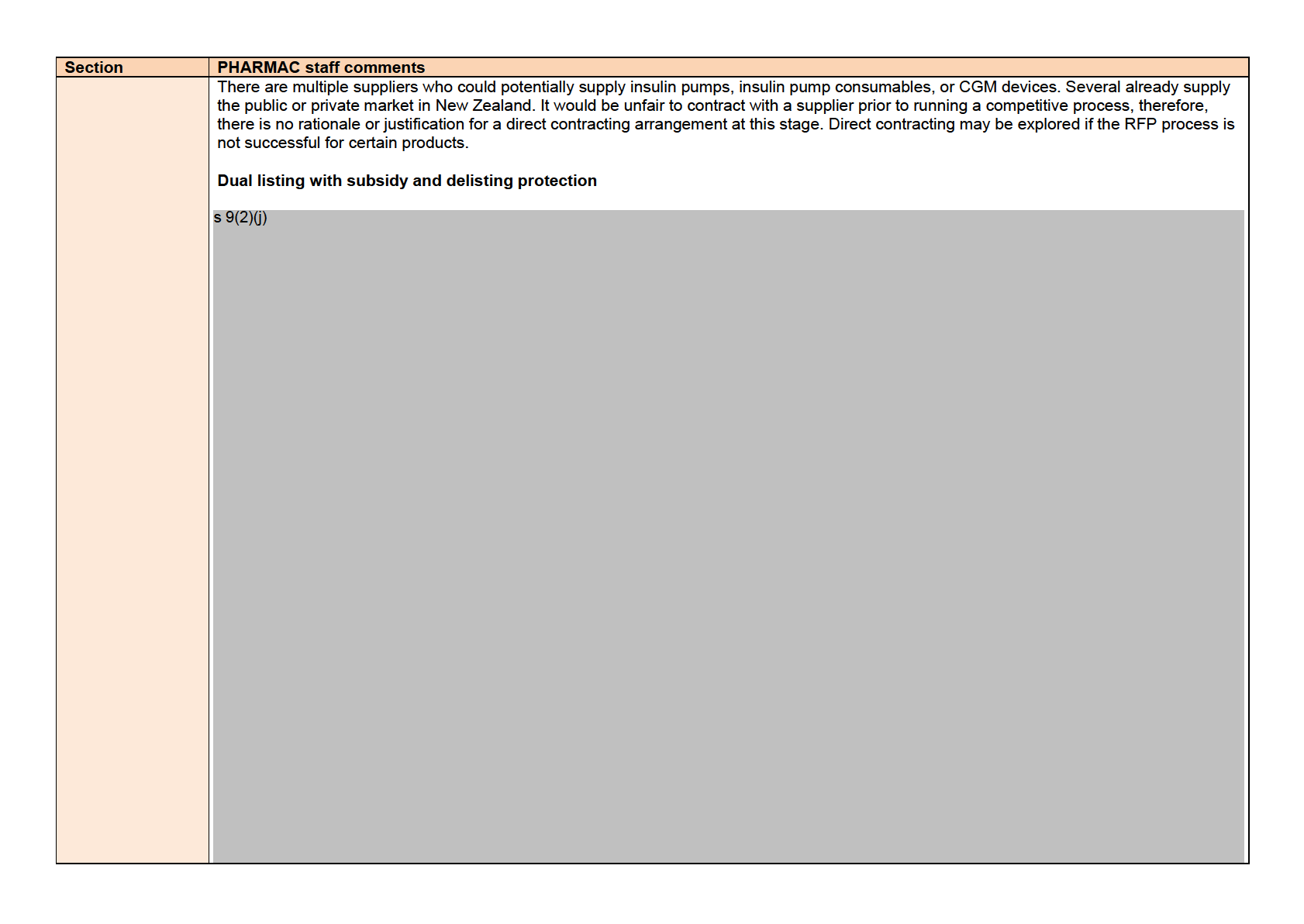
the 1982
Act
under
Released
Information
Official
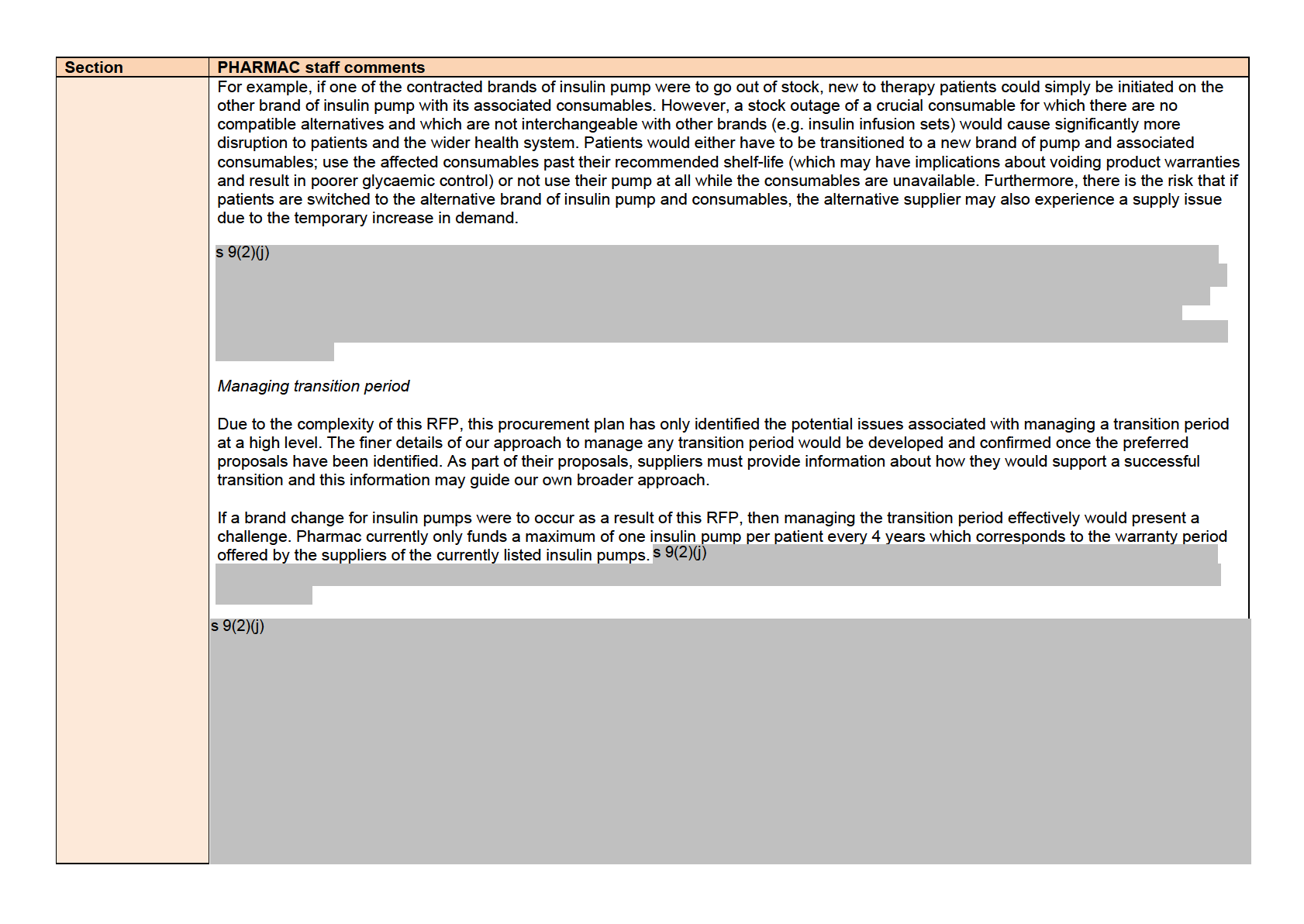
the 1982
Act
under
Released
Information
Official
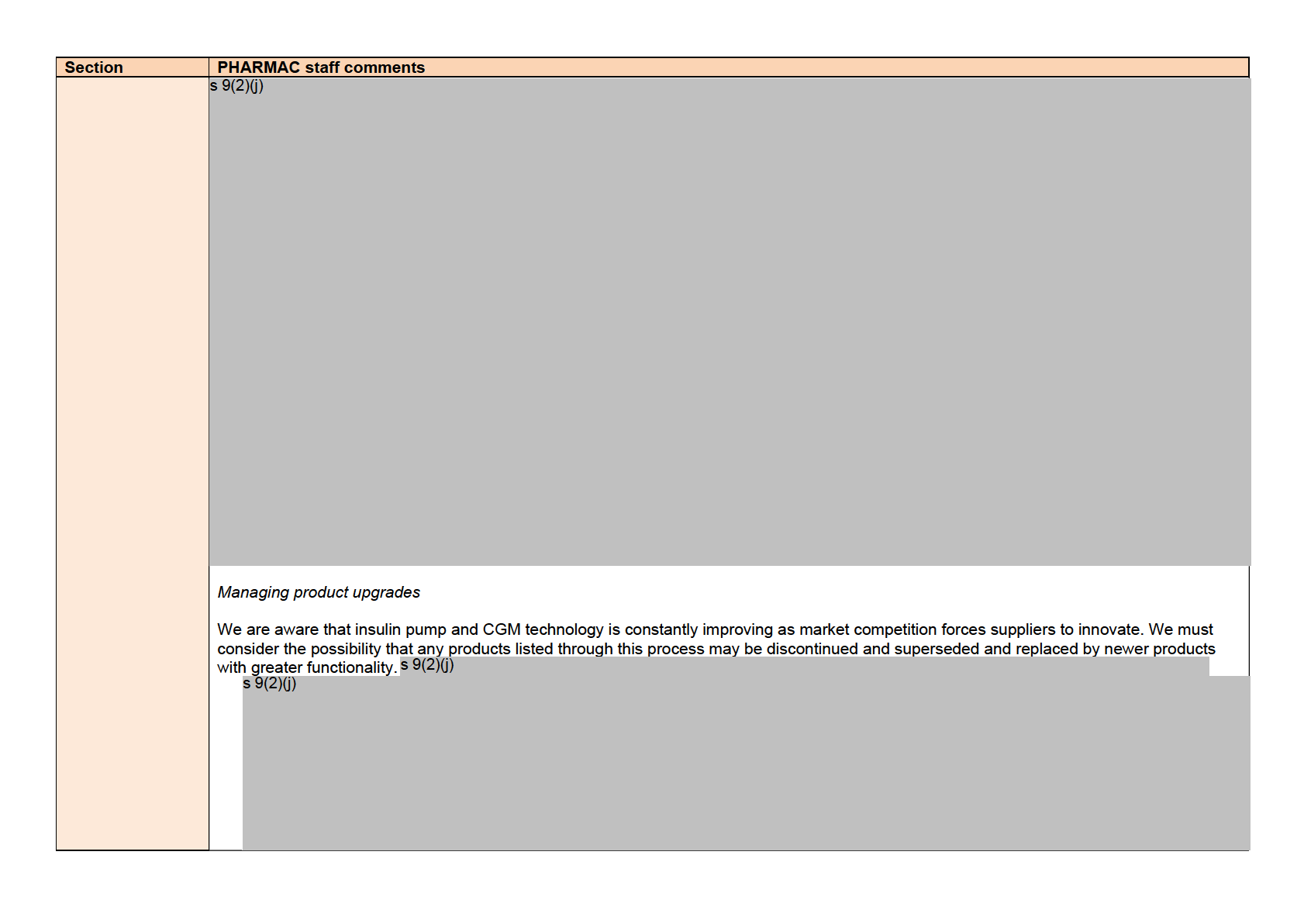
the 1982
Act
under
Released
Information
Official
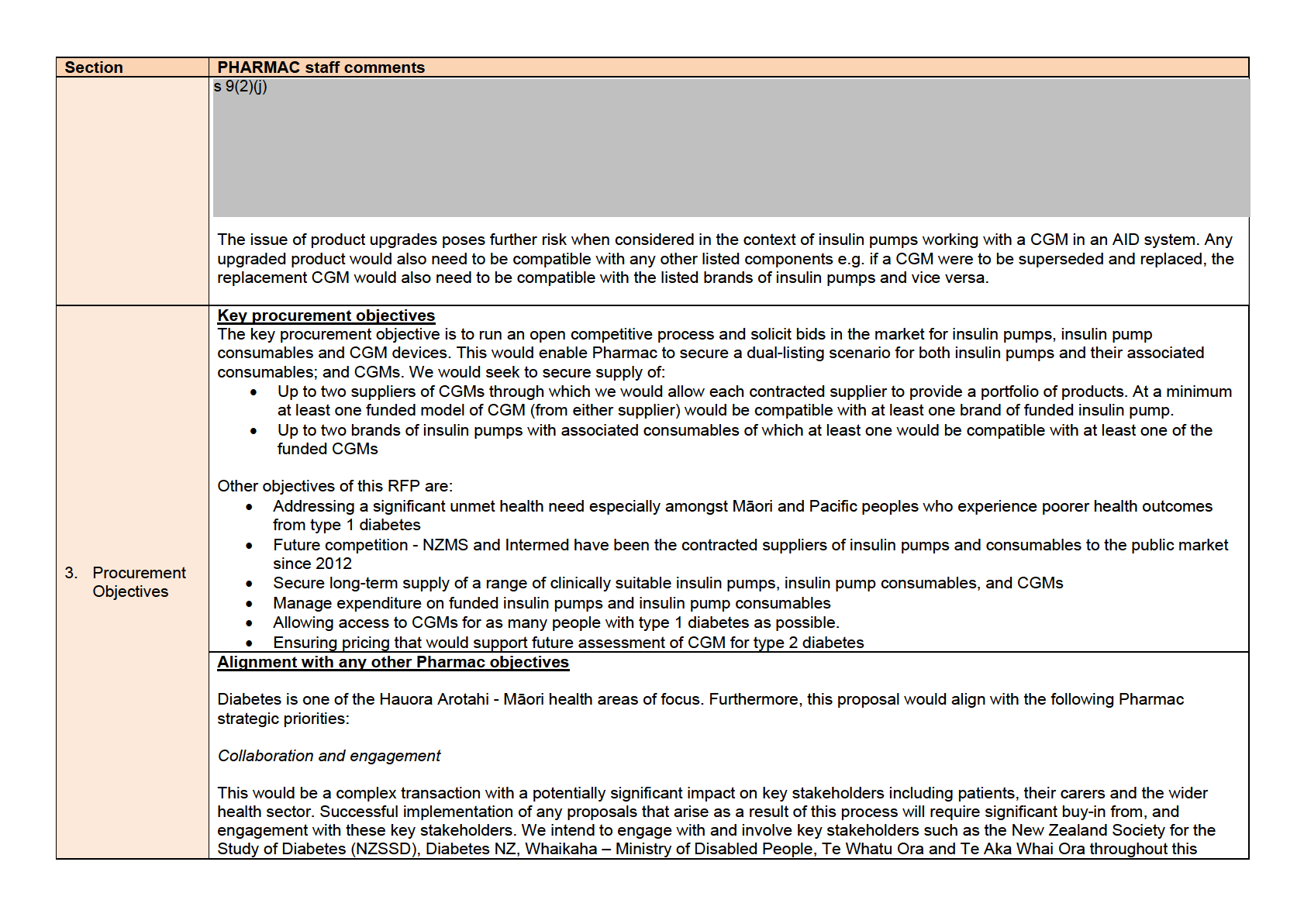
the 1982
Act
under
Released
Information
Official
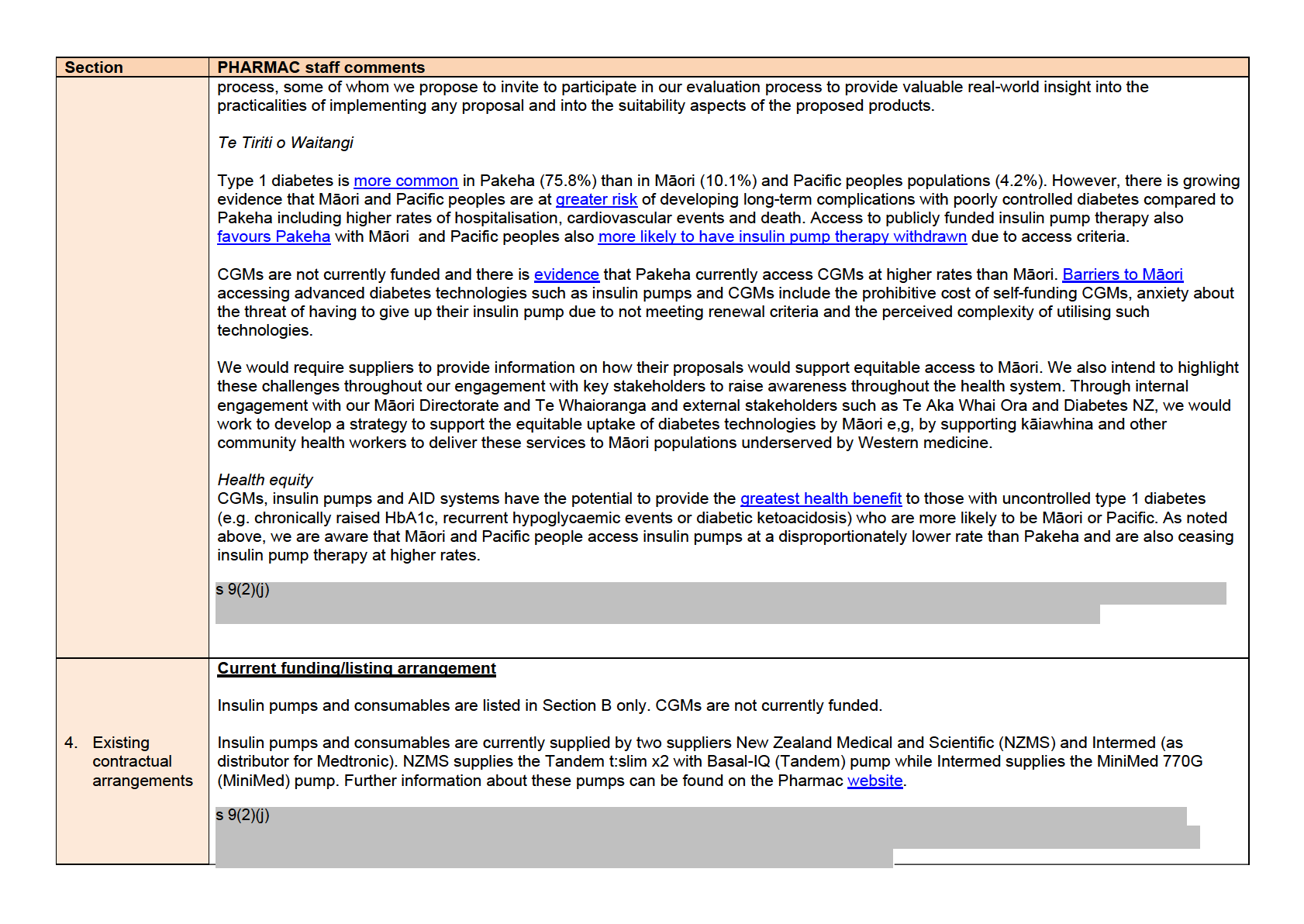
the 1982
Act
under
Released
Information
Official
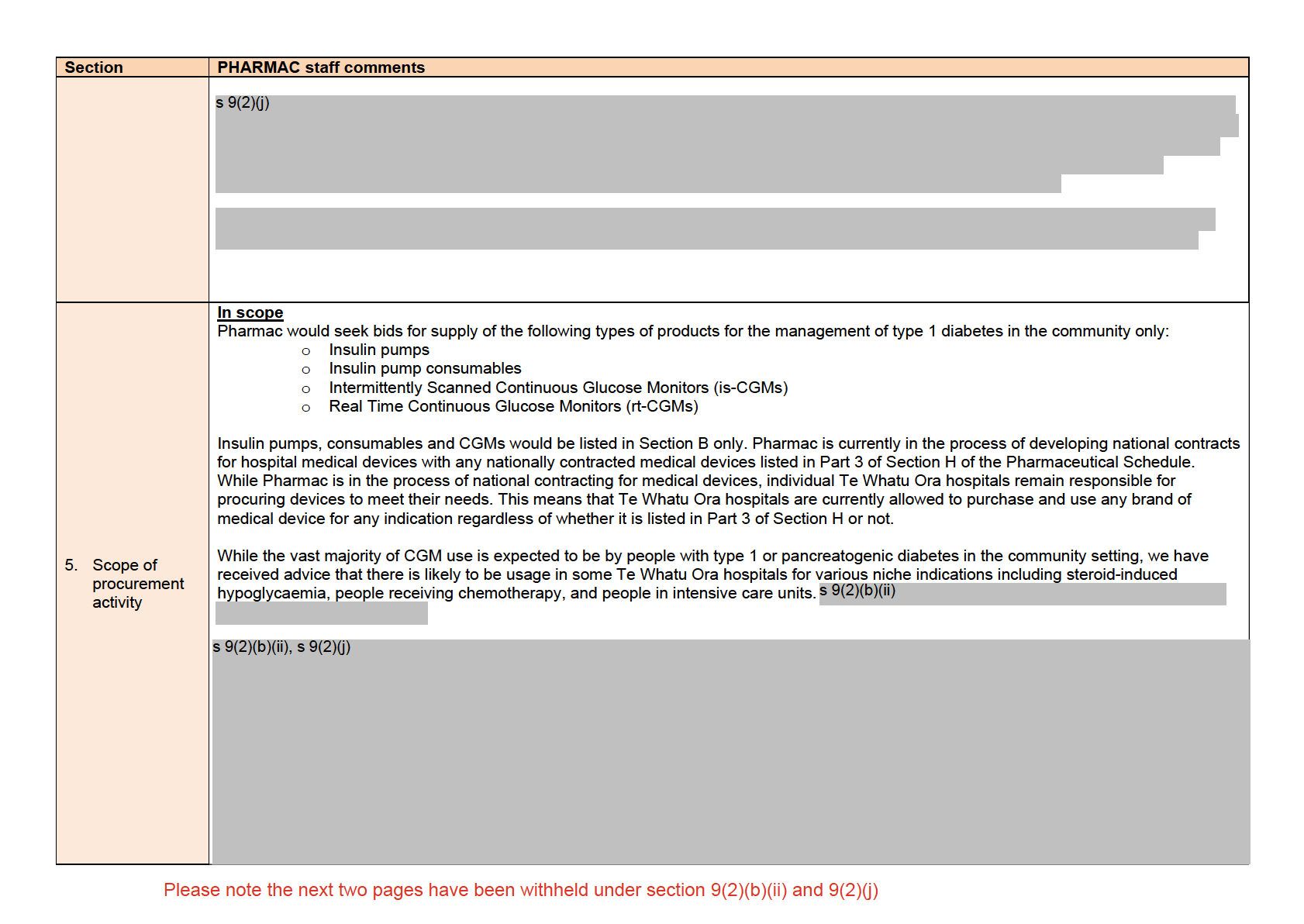
the 1982
Act
under
Released
Information
Official
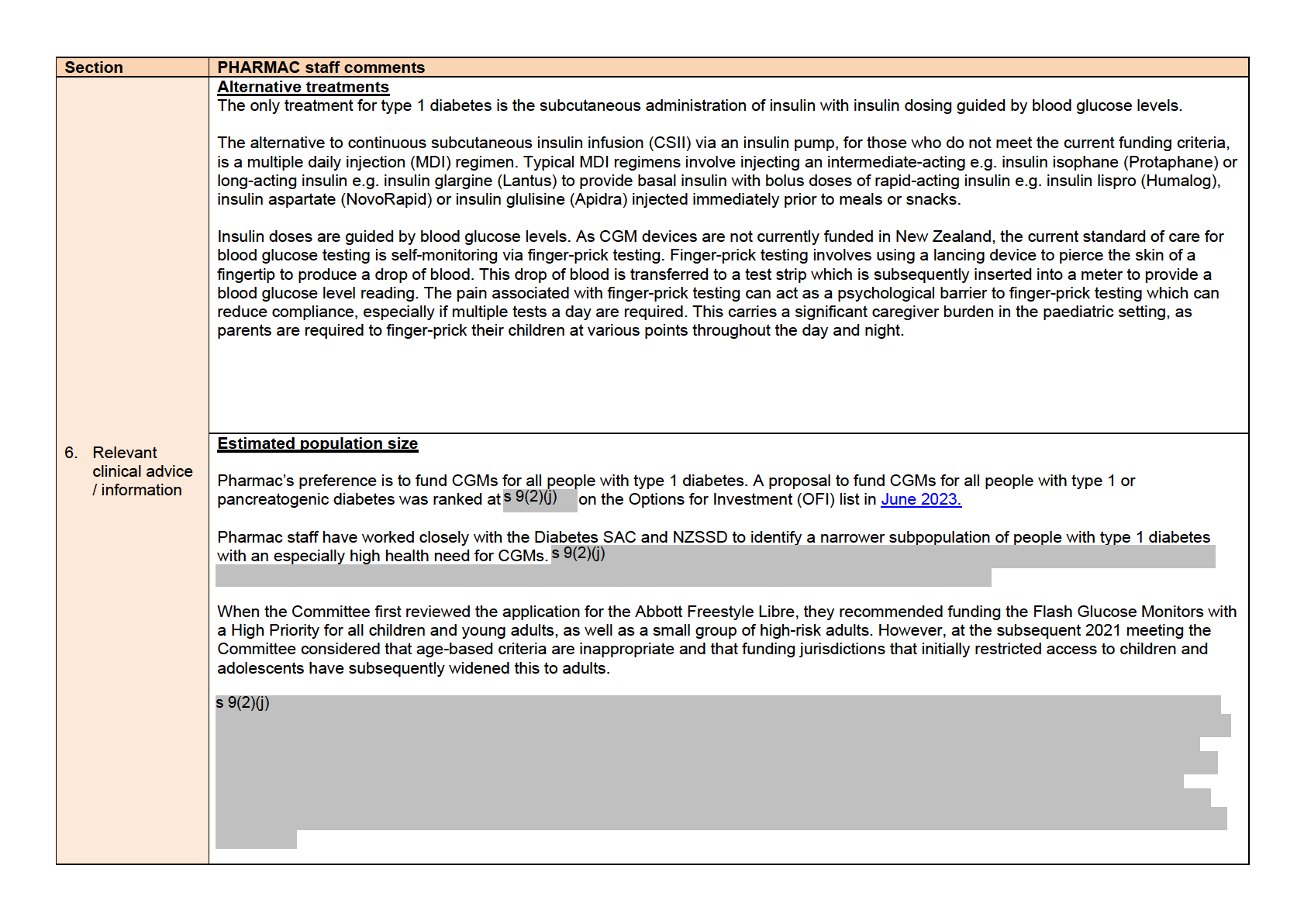
the 1982
Act
under
Released
Information
Official
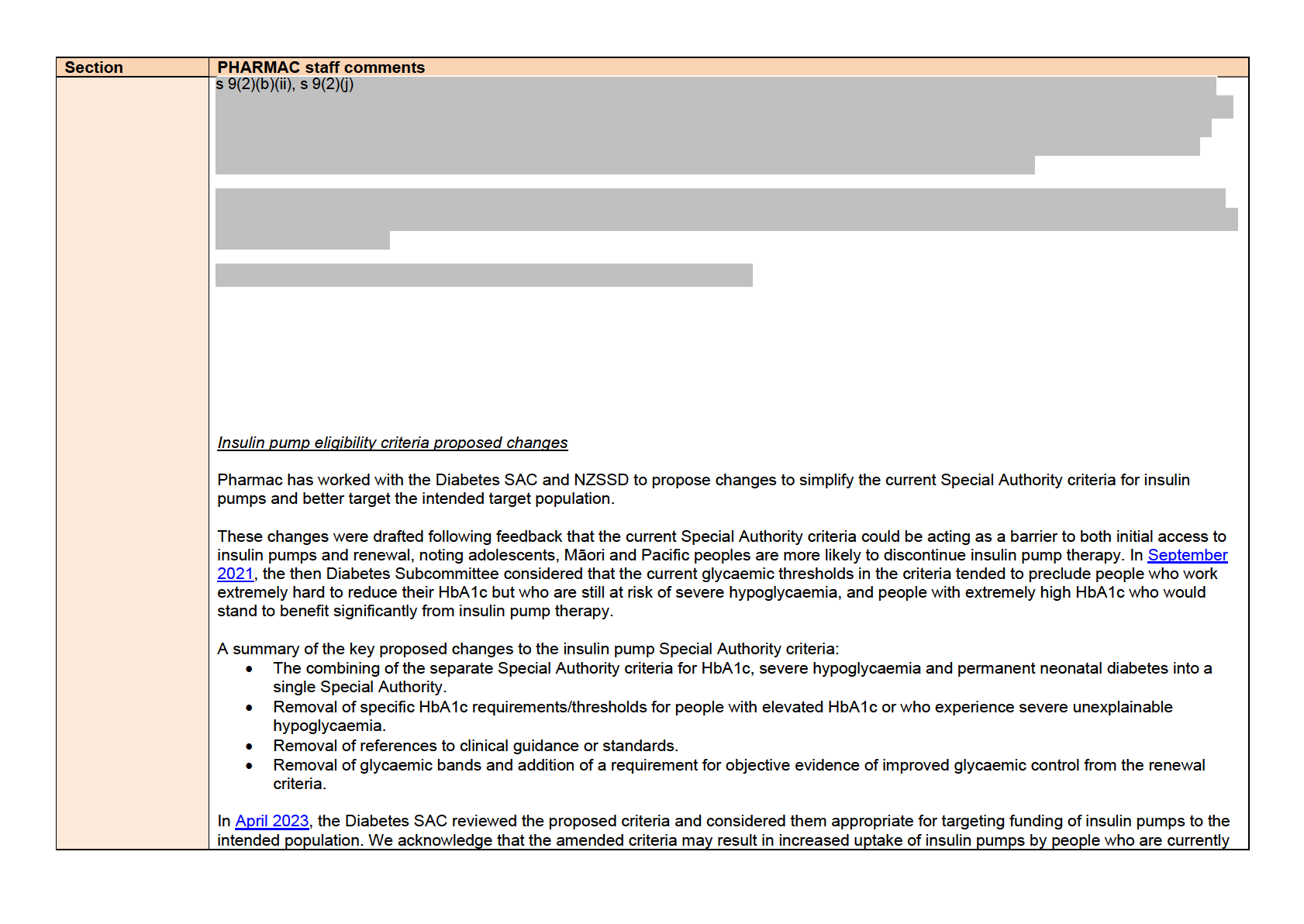
the 1982
Act
under
Released
Information
Official
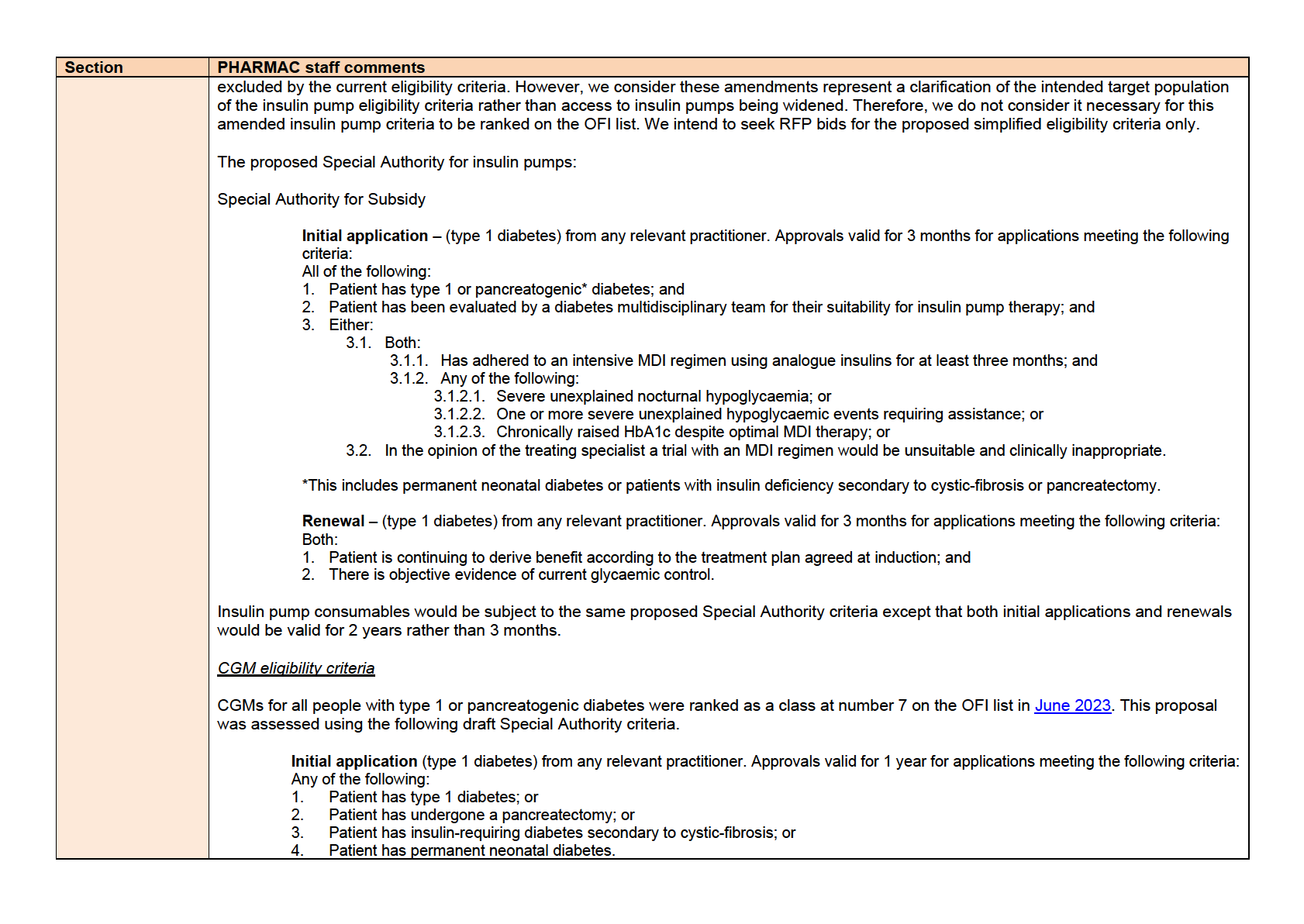
the 1982
Act
under
Released
Information
Official
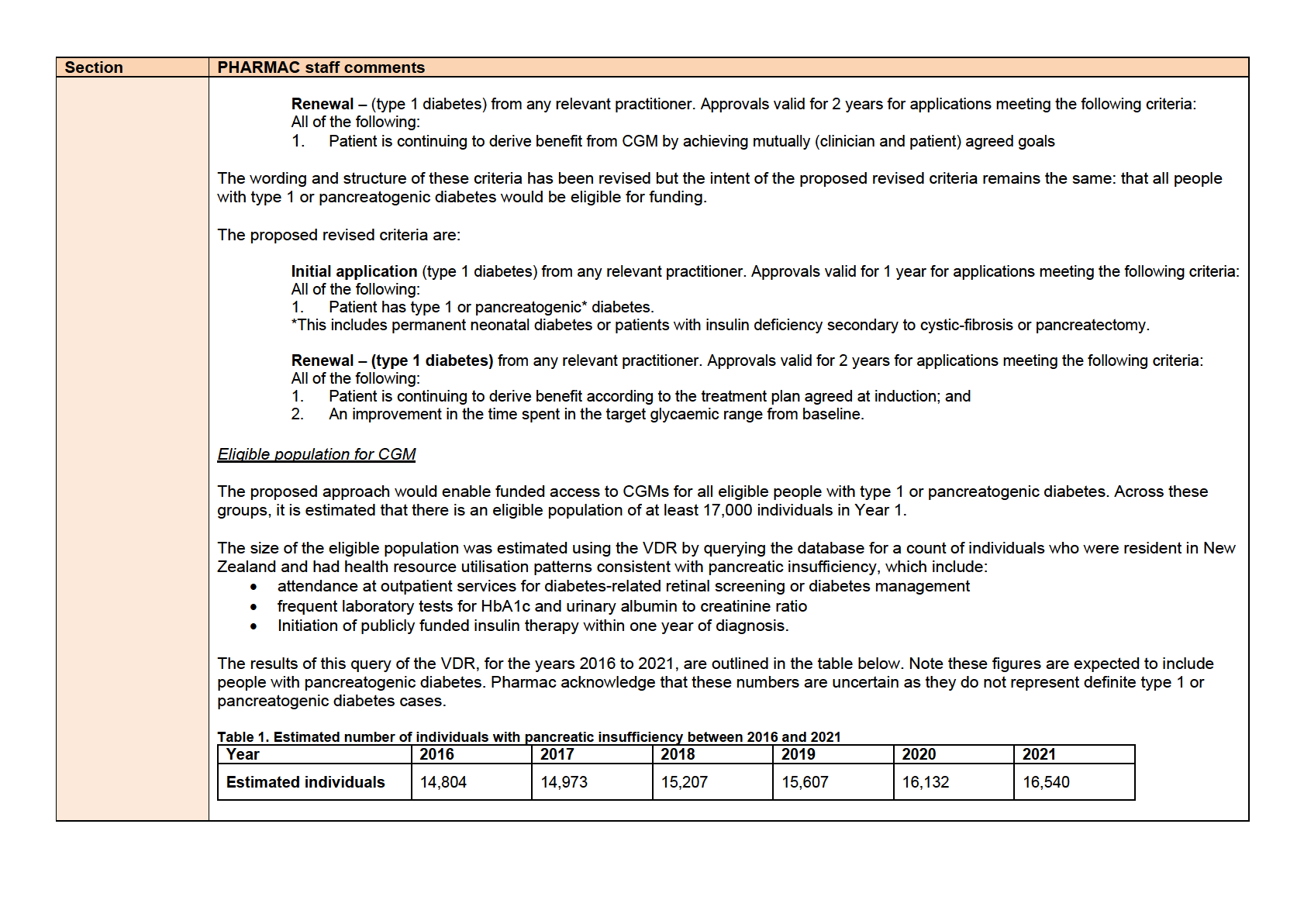
the 1982
Act
under
Released
Information
Official
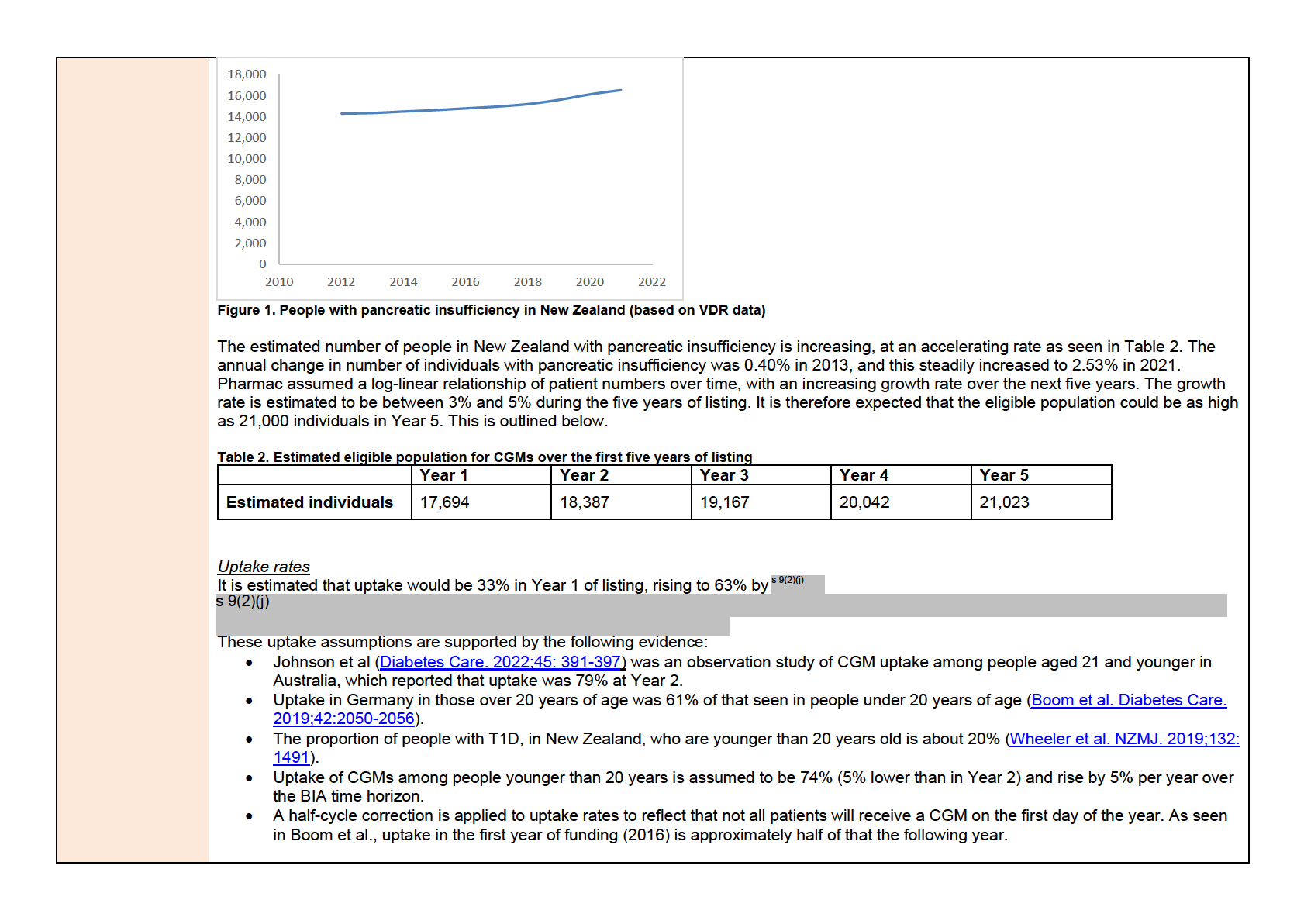
the 1982
Act
under
Released
Information
Official
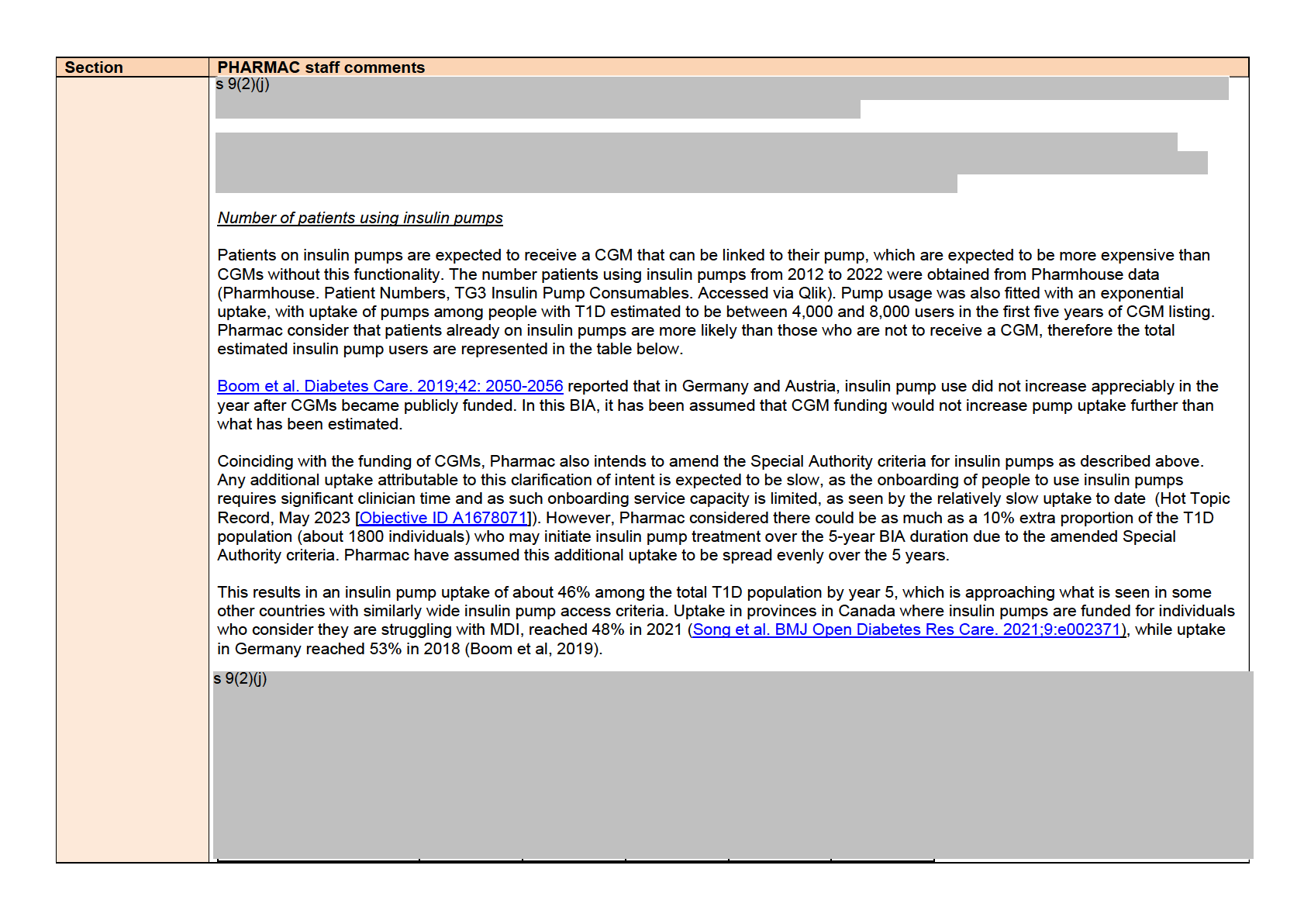
the 1982
Act
under
Released
Information
Official
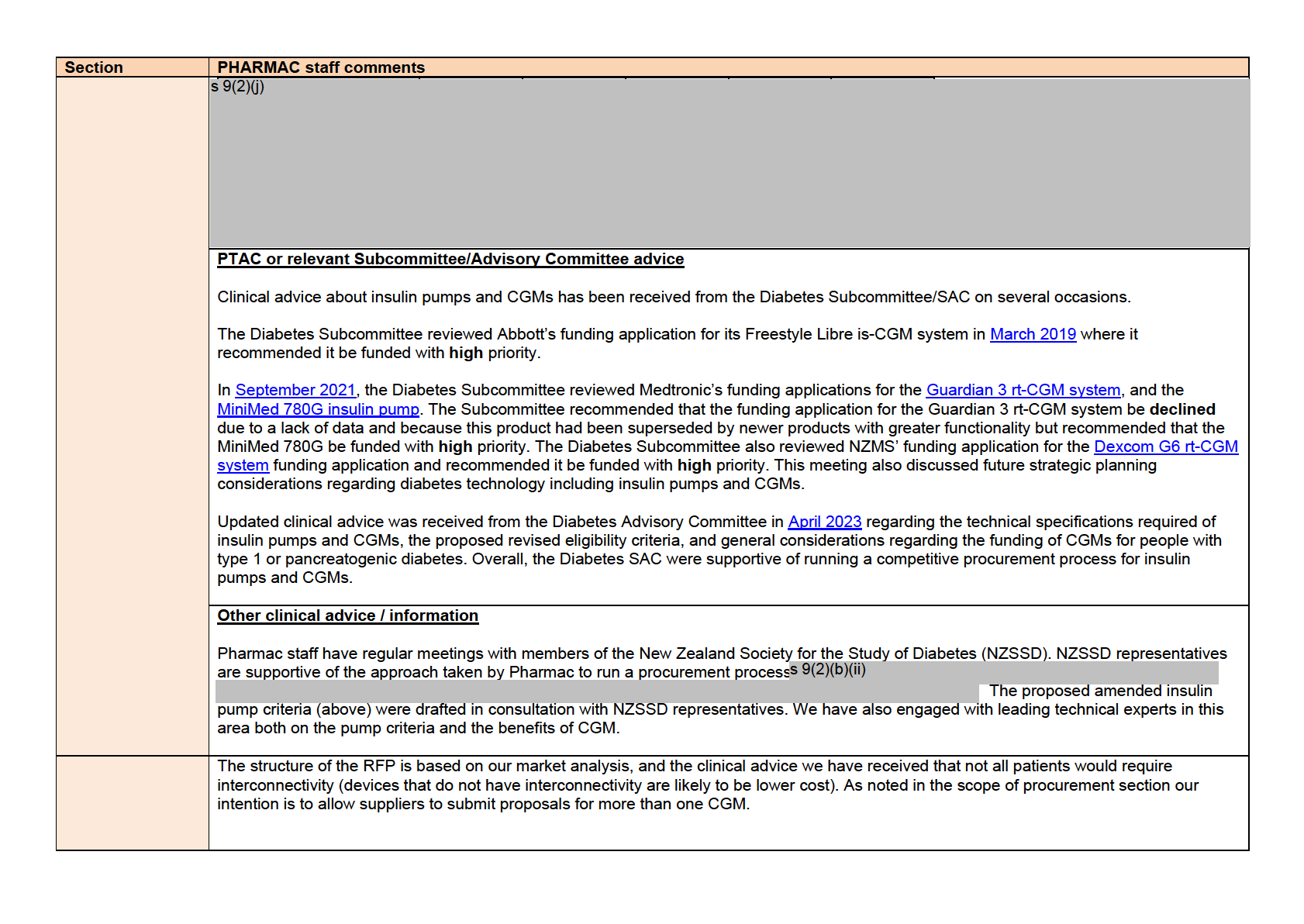
the 1982
Act
under
Released
Information
Official
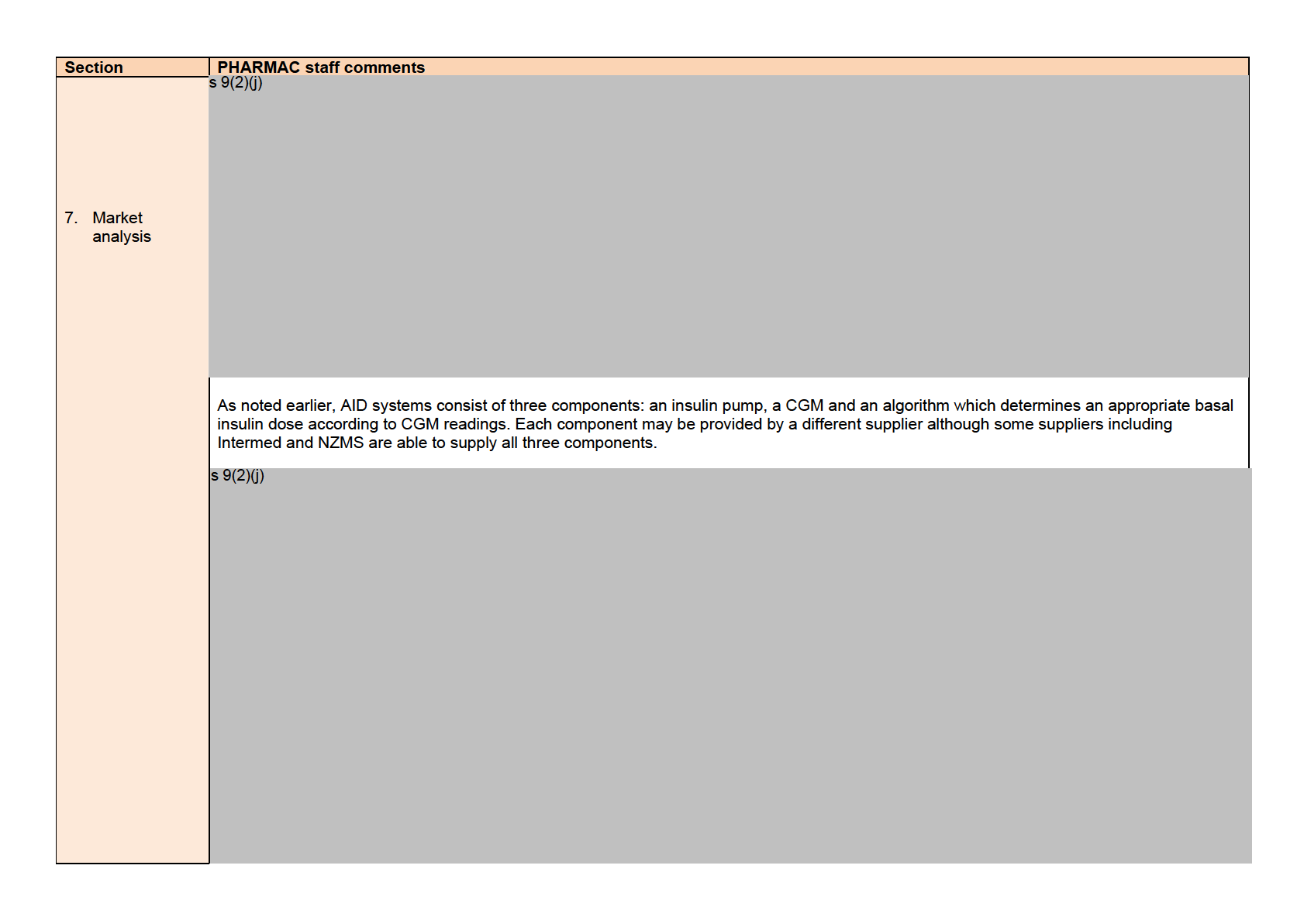
the 1982
Act
under
Released
Information
Official
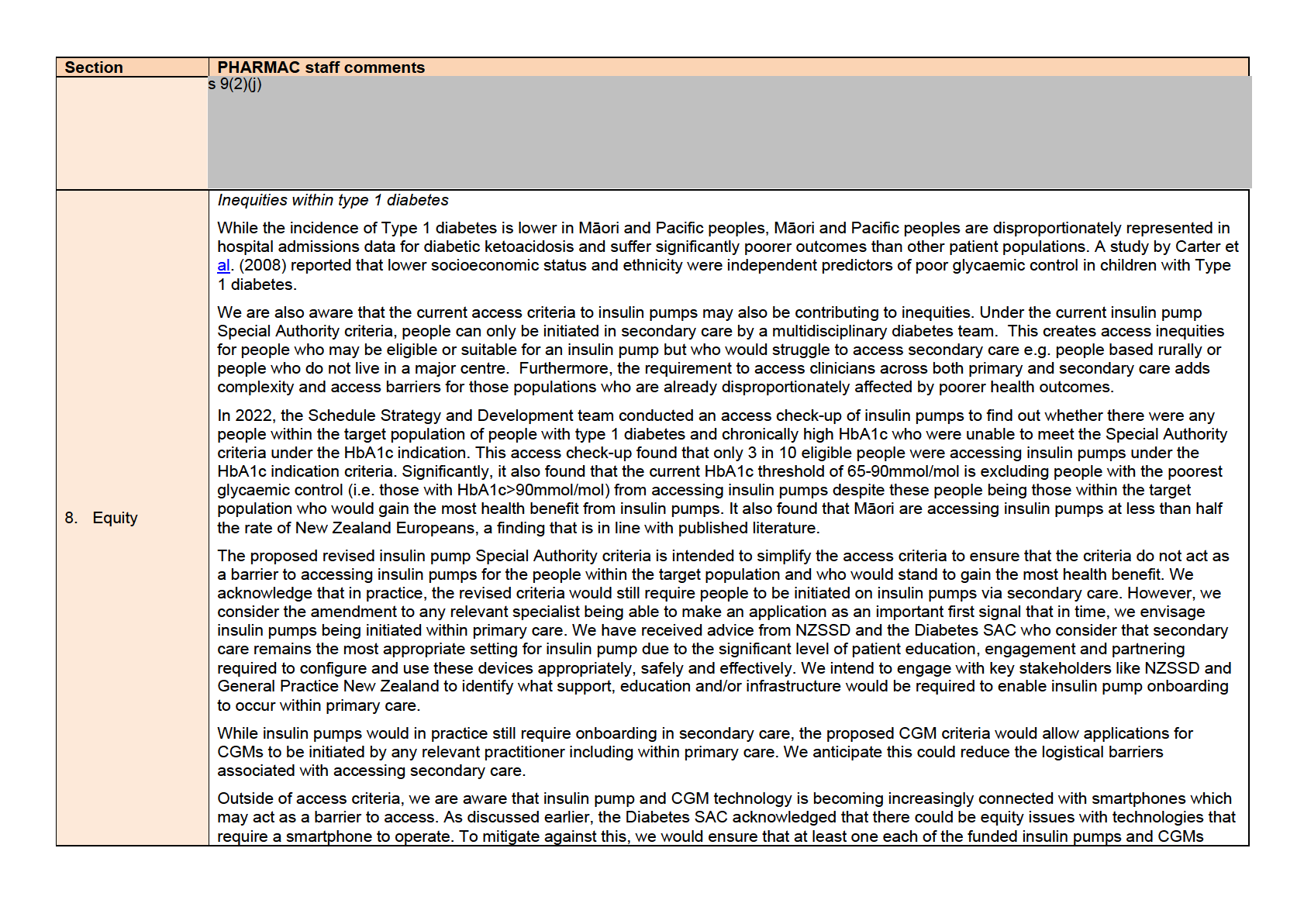
the 1982
Act
under
Released
Information
Official
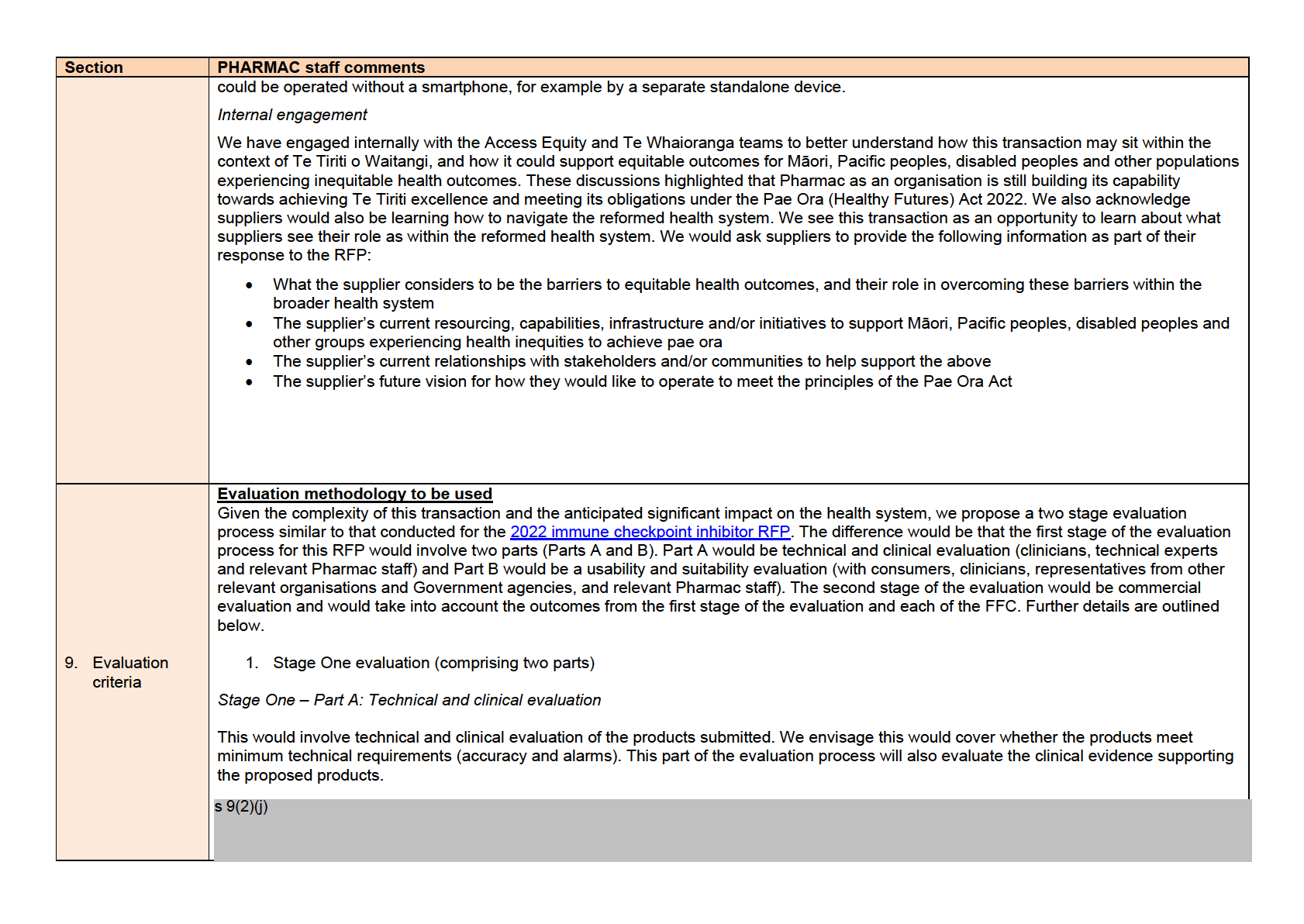
the 1982
Act
under
Released
Information
Official
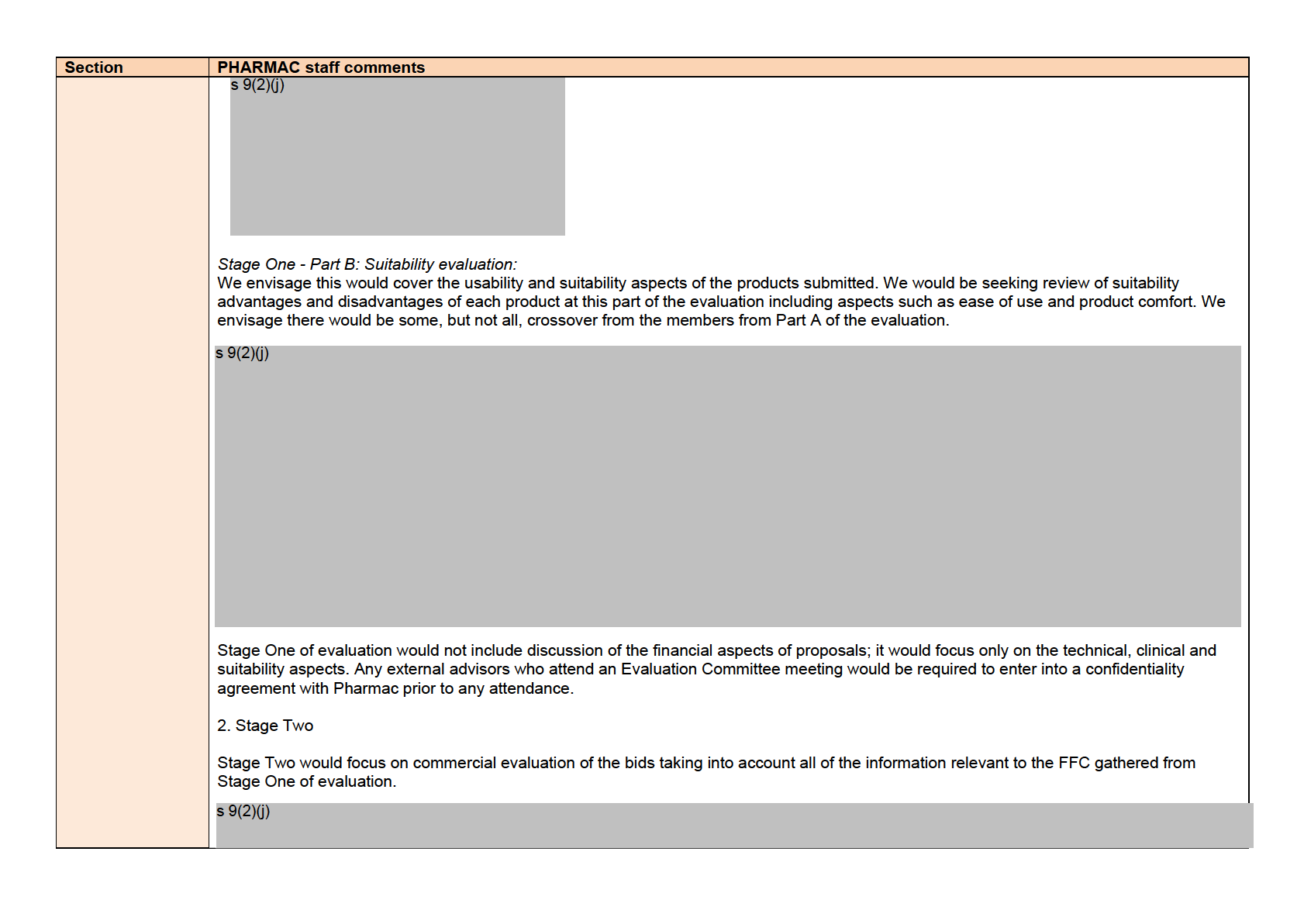
the 1982
Act
under
Released
Information
Official
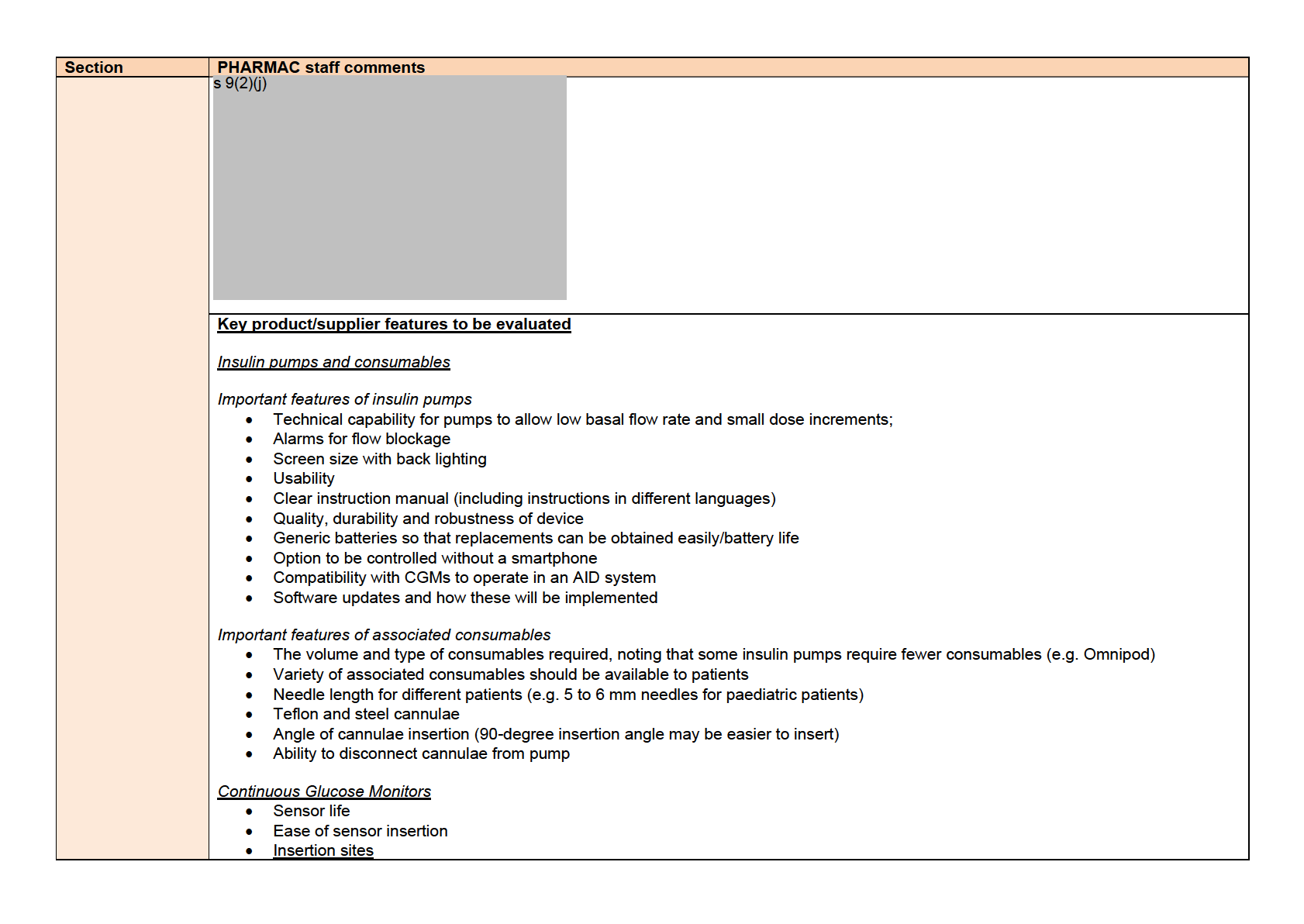
the 1982
Act
under
Released
Information
Official
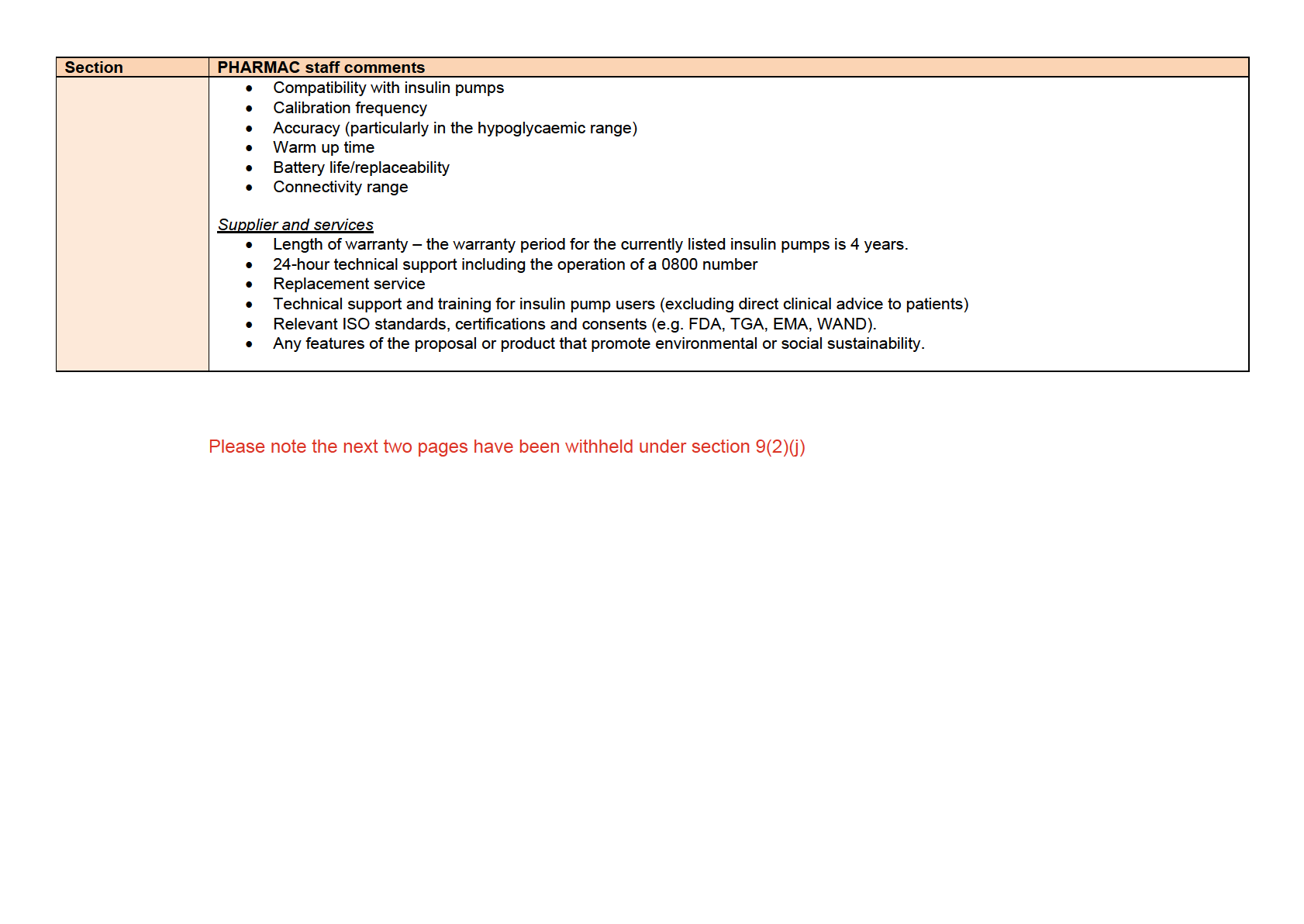
the 1982
Act
under
Released
Information
Official
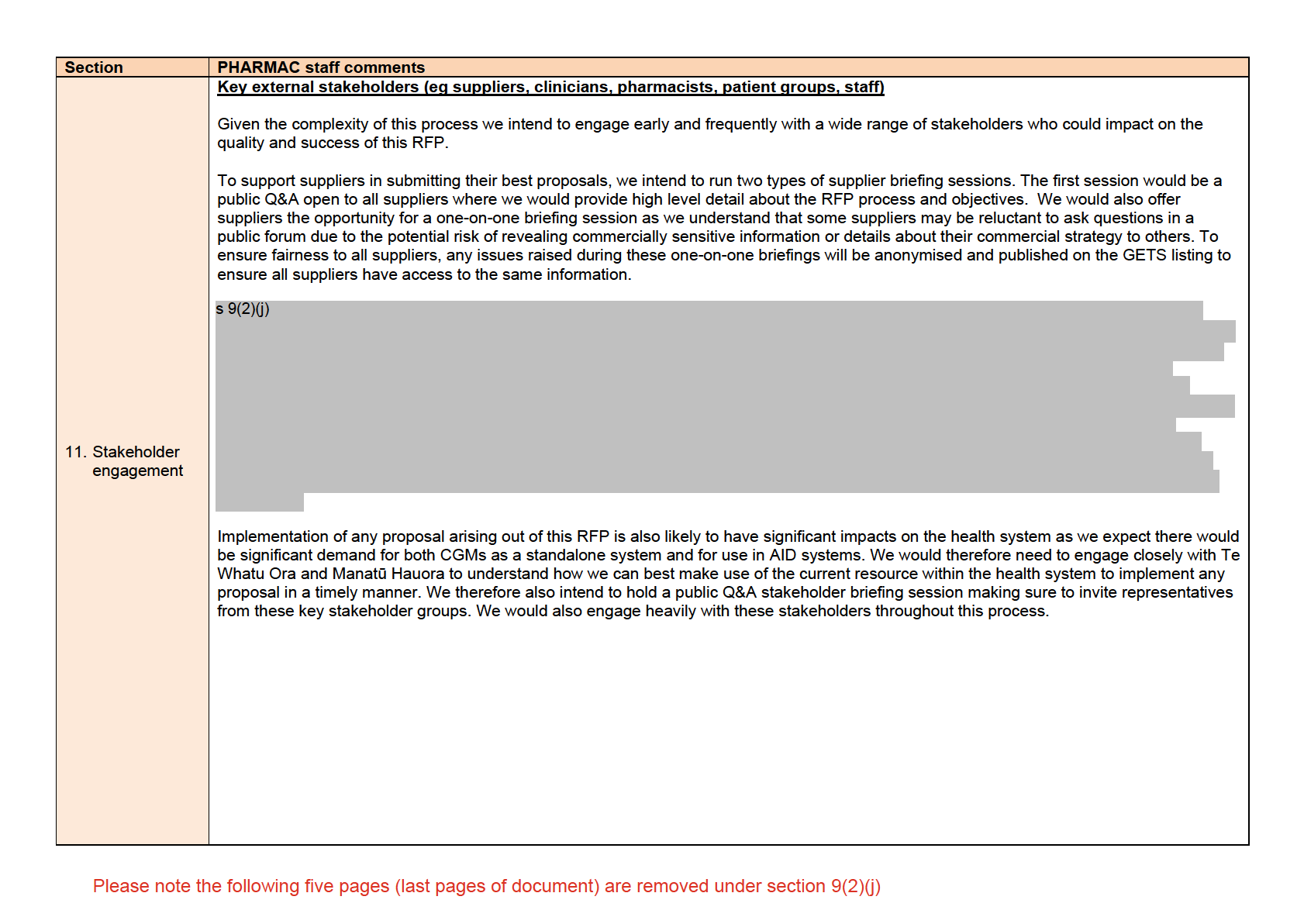
the 1982
Act
under
Released
Information
Official



































